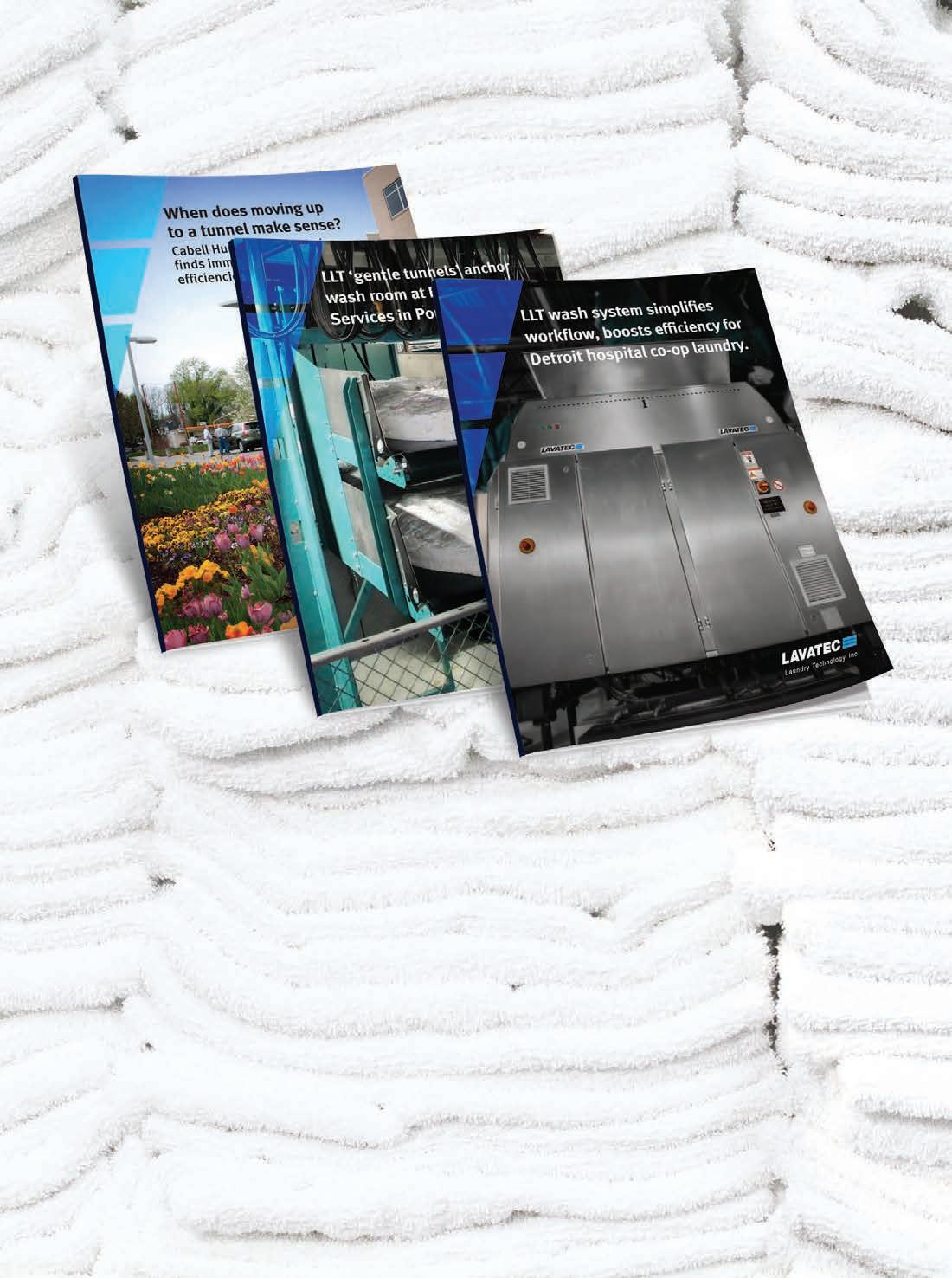AmeriPride opens safety apparel store in North Dakota
WILLISTON, N.D. —
Uniform rental and linen supply company AmeriPride Services has opened a new safety apparel store here that specializes in flame-resistant (FR) and high-visibility apparel, the company reports.
The new store supports AmeriPride’s Bismarck, N.D., production and distribution facility and its team of 135 sales, service and production employees in “providing safety products and expertise to local oil and gas businesses.”
The store offers a selection of FR products, footwear and safety gear.
“We have been serving the Bakken, including the Bismarck, Minot, Dickinson, Glendive and Williston communities, for more than 80 years, and we opened a safety apparel store to demonstrate our ongoing commitment to our customers in the area,” says Wiz Wyatt, vice president of supply chain at AmeriPride. “Our expertise in this area is unmatched in the industry, and the new store supports our local processing plant by providing a place for customers to walk in and easily obtain additional products that meet their safety apparel needs.”

In addition to providing rental and cleaning of uniforms and safety apparel for oil, gas and other industries, the company’s Bismarck facility also offers lease or direct-buy options.
“The processing plant recently added 9,000 square feet to its footprint, and is planning for future expansion,” the company says. ALN
Ensure cleanliness through linen quality assurance program
By Carlo Calma
CHICAGO — For Barbara Williams, operations manager of consultative services at Standard Textile, defining the word “quality” can be somewhat of a challenge.
“Why is it such a challenge?” Williams asks. “Because there is no universal interpretation. Quality means different things to different people.”
Williams tackled the topic in a recent Association for Linen Management (ALM) webinar titled Building a Successful Linen Quality Assurance Program, offering to help laundry managers and healthcare facilities establish best practices and standards in their own programs.
“In today’s healthcare environment, it’s imperative to provide a high-quality, hygienically clean and safe product to the end-user,” says Williams. “With current changes in hospital reimbursements, patient outcomes and patient satisfaction will have a major impact on the financial health of your facility, or your customers. Strong quality assurance programs are essential.”
SETTING CUSTOMER EXPECTATIONS
Regardless of whether a laundry
facility processes rental linens or customer-owned goods (COG), Williams first highlighted the importance of laundry managers soliciting customer input, feedback and recommendations. “You need to solicit customer input as far as their expectations and what they will agree is acceptable product in their system,” she says.
Williams, however, did point out that expectations between a rental laundry vs. a COG plant can differ. “COG is going to have a lot more input … on what those standards of quality should be, whereas a [rental] laundry will also have a large say in the products that they keep circulating in the system,” she says.
Despite the differences in expectations, as a laundry, the goal is providing quality product.
“As laundry managers, you must provide a hygienically clean product in order to minimize the risk of spreading infection, and also provide a clean experience for the customer,” says Williams. “With new research on microorganisms that can survive on textiles, this is extremely important.”
FOLLOWING GUIDELINES
Another set of responsibilities laundry managers must adhere to


in setting up a linen quality assurance program is following regulatory guidelines, says Williams. Organizations such as the Centers for Medicare & Medicaid Services, The Joint Commission, Association of periOperative Registered Nurses and ALM have set standards and guidelines on processing healthcare linen, she says.
Williams adds that not only should laundries maintain a sepa-


ration of soiled and cleaned linen, proper equipment maintenance and chemicals monitoring is essential.
“If the equipment is not maintained, it can destroy the linen,” she says. “And improper chemicals can destroy the linen. It’s important to be sure to provide the proper pH value to your customers for
ALM, ARTA push for better ‘red-bag’ waste education
MISSION, Kan. — Each year, organizations within the U.S. healthcare system spend hundreds of millions of dollars disposing of healthcare linen as infectious or “red bag” waste or regulated medical waste (RMW). These funds are misspent, and could be saved with a few simple safeguards, according to the Association for Linen Management (ALM) and the American Reusable Textile
Association (ARTA).
The main problem is a lack of education on OSHA regulations for the proper handling of healthcare linen contaminated by blood or bodily fluids. This gap in understanding has caused many healthcare facilities to err on the side of caution and train staff to dispose of contaminated linen as red-bag waste, the associations say.

Many healthcare workers would
never consider putting contaminated linen in their own home washing machines. They are probably unaware that professional laundry operators use state-ofthe-art equipment and chemicals to successfully clean millions of pounds of dirty, soiled and contaminated linen on a daily basis, the groups say.
Members of both groups— healthcare laundry operators—
InsIdE
Managing Finances
Eric Frederick offers time-proven advice about handling money.
Panel of Experts
Meet our new group of panelists who will address key issues throughout the year.
estimate that annually as much as 25% of their linen leaves client locations as red-bag waste. A survey last summer of 200 nurses and healthcare professionals at five U.S. healthcare systems revealed that 95% had recently disposed of at least one linen item as redbag waste — even though linen is reusable.
Plant Design Basics
Many factors must be considered well in advance.
january 2014
Late News The newspaper of record for laundry & linen management www.americanlaundrynews.com Volume 40, number 1
[4] [10]
[14] See QUALITY on Page 17
See RED BAG on Page 4
(Image licensed by Ingram Publishing)
Survey: Nearly half of respondents processed more poundage in 2013
CHICAGO — The majority of institutional, commercial and industrial laundry operators report processing more laundry in 2013 compared to 2012, according to results from December’s American Laundry News Your Views survey.
When asked how the poundage processed by their laundry in 2013 compares to 2012’s throughput, 43.2% say “somewhat higher,” while 5.4% say “much higher.” Conversely, nearly 14% say their 2013 throughput was “somewhat less than 2012,” while a small percentage (2.7%) say it was “much less than 2012.” For 35.1% of respondents, the poundage processed by their laundry in 2013 was “virtually the same amount” as 2012.

Laundry managers taking the survey estimated their operation’s overall 2013 production to be up about 1.4% compared to 2012. Respondents’ total estimated poundage for 2013 ranged from 75,000 pounds to 107 million pounds.
Roughly 62% attributed their increase in poundage processed to “more institutional business or increased total accounts,” while onethird (33.3%) attributed the increase to “other” factors, like higher hotel occupancy rates, or providing “new products to existing customers.” (Respondents could choose any or all from among a list of eight factors.)
An even 19.0% say the increase was because they “expanded [their] facility or relocated to a larger site,” while equal shares of 14.3% say it was because they “added more production workers,” or “improved management/marketing ideas.” Roughly 10% pointed to a “redesigned workflow,” while another 9.5% say they “added, replaced or rebuilt production equipment.”
For those whose operations fell short of annual goals or expectations, 53.8% attributed it to “slowing or loss of business,” while another 53.8% attributed it to “other” factors like the reduction of volume at hospitals, or the decline in hospitals’ inpatient census. (Respondents could choose any or all from among a list of eight factors.)
Equal shares of 7.7% say they were unable to meet 2013 goals because of “regulatory changes,” “marketing efforts,” “administration indifference or lack of support,” “productivity of staff,” or “capabilities of equipment.”
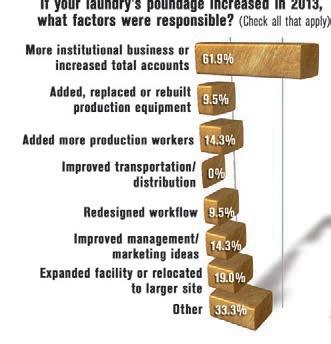
While the Your Views survey presents a snapshot of readers’ viewpoints at a particular moment, it should not be considered scientific.
Subscribers to American Laundry News e-mails are invited to take the industry survey anonymously online each month. ALN

Cintas facilities earn VPP Star certification
INDIANAPOLIS — Two Cintas Corp. facilities in Fort Wayne, Ind., have earned the highest distinction in the Indiana Department of Labor’s Voluntary Protection Program (VPP), the Star certification, according to the state agency.
“Being recognized as a VPP Star site is a proud accomplishment. Cintas’ Fort Wayne facilities are prime examples of the dedication to Hoosier workplace safety and health the department is excited to see,” IDOL Commissioner Rick Ruble says.
VPP Star certification is award-

ed to companies with a commitment to safety and health management excellence and outstanding health and safety records.
To participate, a company must develop, implement and maintain an exemplary worker safety and health management system. Also, the facility’s occupational injury and illness rates must be below the industry national average.
The Cintas Fort Wayne facilities employ nearly 200 full-time workers. Fifteen Cintas sites nationwide have been awarded VPP Star status. ALN
Due to an editor’s error, Ed Kwasnick was incorrectly identified in the December issue of American Laundry News. Kwasnick is director of business development for ARCO/Murray National Construction Co., Oakbrook Terrace, Ill.
American Laundry News regrets the error and apologizes for any confusion it may have caused. ALN
Publisher
Charles Thompson
Phone: 312-361-1680
E-Mail: cthompson@ americantrademagazines.com


Editorial Director
Bruce Beggs
Phone: 312-361-1683
E-Mail: bbeggs@ americantrademagazines.com
Digital Media Director
Nathan Frerichs
Phone: 312-361-1681
E-Mail: nfrerichs@ americantrademagazines.com
Production Manager
Roger Napiwocki
Contributing Editor Jean Teller
Editorial Assistant Carlo Calma
Advertising Sales
National Sales Director
Donald Feinstein
Phone: 312-361-1682
E-Mail: dfeinstein@ americantrademagazines.com
Office Information
Main Phone: 312-361-1700 Fax: 312-361-1685
Subscriptions
630-739-0900 x100 www.americanlaundrynews.com
American Laundry News (ISSN 1091-9201) is published monthly. Subscription prices, payment in advance: U.S. & possessions, 1 year $39.00; 2 years $73.00. Foreign, 1 year $89.00; 2 years $166.00. Single copies: U.S. & possessions $7.00; Foreign $14.00.
Published by American Trade Magazines LLC, 566 West Lake Street, Suite 420, Chicago, IL 60661. Periodicals postage paid at Chicago, IL, and at additional mailing offices.
POSTMASTER, Send changes of address and form 3579 to American Laundry News, Subscription Dept., 440 Quadrangle Drive, Suite E, Bolingbrook, IL 60440. Volume 40, number 1. Editorial, executive and advertising offices are at 566 West Lake Street, Suite 420, Chicago, IL 60661. Charles Thompson, President and Publisher. American Laundry News is distributed selectively to qualified laundry and linen management and distributors in the United States. No material appearing in American Laundry News may be reprinted without written permission. The publisher reserves the right to reject any advertising for any reason.
© Copyright AMERICAN TRADE MAGAZINES LLC, 2014. Printed in U.S.A.
MEMBERSHIPS
2 JANUARY 2014 | AMERICAN LAUNDRY NEWS www.AmericanLaundryNews.com
Association for Linen Management
INSIDE: January 2014 • Vol. 40 | No. 1 [4] Financial Advice for Young and Old Alike Eric Frederick is a believer in simple financial principles, like those revealed by The Richest Man in Babylon [6] Hotel, Motel Show Features Optimistic Tone Manufacturers benefit from resurgence in demand for laundry machinery, chemicals, textiles for NYC rebuilding [8] Tools of the Trade [10] 2014 Panel of Experts Introductions Meet the newest members from across the industry who will answer our laundry management questions in 2014 [14] Plant Design: Getting Back to Basics We ask a quartet of laundry design experts about some of the challenges that await your next project [18] OPL 101 UniMac’s Bill Brooks shares how to organize and optimize on-premises laundry space to improve productivity [19] Trade Ticker
Correction
IF YOU DON’T HAVE OPTISPRAY
YOUR
LINENS AREN’T THE ONLY ONES TAKING A BATH.
An inefficient rinse is money down the drain. With a combination of bath and spray rinses, new OPTispray ™ Rinsing Technology utilizes unique spray hardware and exclusive software to minimize the water and time needed to rinse a load while also delivering far superior rinse results. OPTispray uses less water, saving up to $2,110 in yearly utility expenses compared to popular models with only bath rinses. To lower costs even further, industry-leading 400 G-Force extraction delivers maximum water removal and increased throughput. Innovative features like UniLinc ™ paired with OPTidry ™ offer complete laundry room control, minimize operating costs and optimize efficiency to save you even more time and money. It all combines to deliver the industry’s absolute lowest cost of ownership. CUSTOMIZED FINANCING designed specifically for on-premises laundry. Contact an authorized UniMac ® distributor today to run a laundry operating analysis and see how you can cut costs and save money. Visit UNIMAC.COM/OPTISPRAY or call 1-800-587-5458.

™
More accessible than ever
american Laundry News has been the “Newspaper of Record for Laundry & Linen Management” for 40 years, and now we’re making our industryleading magazine more accessible than ever.
On behalf of our staff, I’m proud to announce that American Laundry News is now available to read on your iPad or Android tablet.
Using Mirabel Technologies’ Magazine Central app, which you can download free from the App Store or Google Play, you have the ability to read our magazine anytime, anywhere. This e-reader packs plenty of punch.
Magazine Central supports

red Bag
continued from Page 1
When hospitals allow contaminated linen to be disposed of as red-bag waste, they unnecessarily spend money on waste disposal fees, and then incur additional replacement costs, ALM and ARTA report. This is one area where hospitals can easily and substantially decrease operating expenses.
That’s why the groups began researching the situation last year, and asked the Occupational Safety & Health Administration (OSHA) to confirm proper protocols for handling healthcare linen soiled with blood.
In late October, OHSA sent a “Letter of Interpretation” that confirmed that linen contaminated by blood or bodily fluids is not trash or waste. It also reaffirmed existing OSHA regulations, which specify that any linen saturated with blood or other potentially infec-
reading in either portrait or landscape mode. URL elements on any page are active (meaning you can “click through” to a website mentioned in a story or ad). And the app provides you
the tools to share pages or to clip and share content across multiple media platforms, including Facebook and Twitter.
It’s easy to get started. After you’ve installed and opened the app, type “American” into the search bar. Select the issue you’re interested in reading and click “Download,” then “View.” That’s it!
The Magazine Central app stays on your mobile device, and you can check back each month to download the latest issue.
We’ve just begin to scratch the surface of what this e-reader app can do for our magazine and for you. Remember — we’re always just a download away. ALN
tious materials (OPIM) should be placed in impermeable bags. A facility’s laundry personnel then picks up the bagged linen, washes the goods, and delivers clean linen. The letter also verifies the proper protocols for handling contaminated linen, and states that bags used to collect contaminated linen must be correctly labeled.
Buoyed by OSHA’s recent letter, the associations are developing an awareness campaign. In addition to sharing the information with healthcare associations and facilities, they plan to provide education materials for members to help train and educate healthcare clients on the correct, less costly methods for handling contaminated linen.
“We hope having this confirmation will provide laundry operators the evidence they need to shift thinking of healthcare risk managers and administrators that educate staff to treat contaminated linen as red-bag waste. We also are partnering with Practice Greenhealth and AHE to help educate their members,” says ARTA Executive Director Nancy Jenkins. ALN
Spending Statistics for Red-Bag Waste
The following statistics, from 2012, place some perspective on how much money is spent on red-bag waste:
• The healthcare sustainability association Practice Greenhealth1 estimates its 1,900 member hospitals generated an average of four (4) pounds of red-bag waste per patient per day.
• Hospitals pay between 18 and 33 cents a pound to dispose of red-bag waste.
• According to the American Hospital Association2, there are 5,724 hospitals in the United States that in 2012 admitted 36,564,886 patients.
• Stericycle3, one of the nation’s leading waste haulers, reported revenue of $1.2 billion for disposing of hospital-regulated medical waste (RMW or red-bag waste).
1. Practice Greenhealth environmental surveys, 2012
2. AHA Fast Facts 2013 (for 2012 data)
3. Stericycle Annual Report, 2012
Valuable financial advice for young and old alike
•
•
•
•
•
•
•
From AmericanCoinOp.com:
•
•
d
uring the past year, I have had more time than normal to read. So I have endeavored to try and broaden my base of knowledge by reading various management books. As we start a new year, I would like to recommend a small but powerful book to the loyal readers of my monthly column.
The book is titled The Richest Man in Babylon, by George S. Clason. This simple, 144-page book reportedly contains the money management secrets of the ancients. I originally found this book as a newlywed back in 1970, and while I found its ideas interesting, the formula for financial success laid out in the book seemed too simple to be believable. Now, 43 years later, I have become a true believer of its simple financial principles.
For those of you close to retirement, or those who have many years to go, the financial doctrines presented in this tome will help you secure your future. The first rule to financial freedom is to pay 10% of your income to yourself first.
I have always taken pride in paying all my bills on time. But there have been times when paying all my bills took all the money I earned. I learned the sad fact that wants, needs and desires expand as quickly as my pay. When I decided to pay myself first, and learn to live on the rest, I began to really enjoy life.
I decided to take advantage of my company’s 401k program. It was willing to match 50 cents on the dollar up to 5% of my salary. By putting in 7.5% of my pretax paycheck, I was able to save a total of 10% of my income. This is a great long-term saving program, but we all need to have access to extra cash every once in a while. Therefore, I started regularly putting an additional 10% of my paycheck directly into my credit union account. It was amazing how fast the money added up, and how great I felt as the money grew.
My wife and I learned to live on the other 80%. We tried to watch our expenses, and made sure that we stayed within our spending limits. At first it was difficult, but after a little practice it began to come naturally. We put no restrictions on where or how we spent this 80%. We were free to spend any extra cash we had, after paying our regular monthly expenses, on trips, clothes, movies or any other luxury we desired. The idea is not to forego the fun things in life, but to pay for them out of your 80%.
The second rule is to profitably invest your savings. The concept is to put your savings to work so that they can increase without risking the principal. As the years pass, it multiplies itself in surprising fashion.
The third rule is that money clings to the protection of the cautious owner who invests it under the advice of men wise in its handling. You have worked hard for your money, and you want to protect it. You also need for it to go to work for you so that it can earn a respectable rate of return. It is therefore necessary for us to seek the advice of professionals in how to invest our money in profitable ventures that will ensure the safety of our savings and its return.
The fourth rule is that money slides away from the man who invests it in businesses or purposes with which he is not familiar, or which are not recommended by those skilled in investing.
The simple fact is that there are no shortcuts to the accumulation of wealth. The most valuable commodity we have in the accumulation of wealth is time, which is given to all of us freely and equally. People who are disciplined enough to pay themselves first (at least 10%) on a regular basis will learn the value of time, and with that the time value of money.
The important thing to remember is that it is never too late or too early to start.
Eric Frederick is director of laundry services for Carilion Laundry Service, Roanoke, Va., and a past president and manager of the year of the Association for Linen Management. You can reach him by e-mail at efrederick@carilion.com.

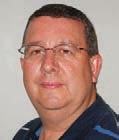
4 January 2014 | american Laundry news www.AmericanLaundryNews.com Top Stories Appearing on AmericanLaundryNews.com for the 30 Days Ending Dec. 15 (WE) = Web exclusive news • B&C Technologies Unveils 2014 Product Line During Sales Meeting
AmeriPride To Open National Distribution Center in Memphis
•
Alliance Laundry Systems Moves Forward with $46 Million Expansion
Starr Textile Services Celebrates Grand Opening of New Plant
•
Racetrack/Casino Turns to RFID to Track Staff Uniforms Columnists/Features
Which Soiled-Linen Collection Method is Best?
•
OPL 101: Outfitting an On-Premises Laundry Room
Train, Protect to Prevent Chemical Injuries
Designing Success: Chicago Dryer Co., Milnor and Turn-Key Industrial Engineering Services, for Florida Hospital Laundry our sister websites
AmericanDrycleaner.com:
From
Managing Drycleaner Employees by the Book
StatShot: Northeast Sees Strong October; Utilities Cost Up (WE)
Laundry Leases: Assets Worth Protecting
Make Owning Chain of Coin Laundries Your Goal
From The Director’s Chair
Bruce BeGGs
COLUMNIST AT LARGE Eric L. Frederick, RLLD
ALN



Hotel, Motel Show features optimistic tone
BY RichARd meRLi
NEW YORK — Managers of laundries, hotels and motels took advantage of the opportunity to learn about the cost savings associated with new laundry machinery, textiles and chemical systems on display at the 98th Annual International Hotel, Motel + Restaurant Show (IHMRS).
Many product manufacturers indicated that they are benefiting from a resurgence in demand for new laundry machinery, chemicals and textiles as a result of efforts to rebuild hotel and motel properties damaged by Hurricane Sandy last October.
Attendance for the Nov. 9-12 event at the Jacob Javits Convention Center was 15,996, an increase of 11.3% over last year’s total of 14,366, according to Megan Alexander, a spokesperson for the show’s management. The increase in attendance reflects the recovery of New York’s economy following last year’s hurricane, she says.

“Central Jersey and Long Island were devastated by Hurricane Sandy, and business was down,” says Vince Burkett, director of marketing for Harbor Linen, based in Cherry Hill, N.J. “But business has rebounded this year. Floor traffic is back at the show. We’re feeling optimistic about the show this year.”
A similar sentiment was expressed by Kendra Keller, a sales executive for Frette, a manufacturer of high-end bed, bath and terry items for the hotel market. “We’re very pleased with the floor traffic this year,” she says. “This is a good show.”
Direct Machinery Sales Corp., a distributor of laundry machinery for Pellerin Milnor and Chicago Dryer Co., has gotten “steady work” replacing laundry machinery in facilities flooded by Hurricane Sandy, according to Joe Rossitto, a sales manager. “It’s not simply a matter of a quick repair when laundry systems are flooded with saltwater,” Rossitto says.
Chicago® and Milnor shared a booth at the show. Milnor exhibited a new 60-poundcapacity rigid-mount washer and a new 60-pound-capacity soft-mount washer, while Chicago® exhibited its new Cadet ironer and a towel folder. The show produced “a good quality of leads” for the companies, Rossitto says.
Speed Queen also saw “more activity and a fair amount of replacement of laundry equipment on the Jersey Shore,” especially in the spring, according to John Smith,
regional sales manager for the company. Speed Queen is part of Alliance Laundry Systems, based in Ripon, Wis. The company exhibited a 60-pound-capacity washer at the show for the first time.
“This show is a little better than last year’s, which took place in the wake of the hurricane,” Smith says. “There have been surges of traffic and interest.”
UniMac, a sister company, made interactive equipment available at the show to enable visitors to better understand its OPTispray Rinsing Technology, designed to save both energy and water, and its UniLinc Control System. Designed with both washerextractors and tumble dryers in mind, the advanced controls provide ease of use across all machines. The new systems drew strong interest from show visitors interested in cost savings and efficiencies, according to Craig Madson, national accounts sales manager.
Maytag, which exhibited a 55-poundcapacity soft-mount washer and a 75-poundcapacity dryer, also has seen an increase in demand for replacement laundry machinery among hotel and motel properties along the New Jersey shore, according to Steve Hietpas, business development manager for the company. “This has been a good show for us,” he says.
Xeros Cleaning, a United Kingdom-based company that is expanding into North America, drew strong interest at its exhibit by demonstrating its patented polymer bead technology washing process, designed for hotels and industrial laundries. The system is designed to use 70% less water, 50% less detergent and up to 50% less energy to wash linen.
The technology originally was developed from pioneering work at the University of Leeds in the United Kingdom. It was commercialized by Xeros, which recently opened its North American headquarters with an office in Manchester, N.H.
“Hotel property owners are interested in preserving their high-end linen and lowering their linen replacement costs,” says Xeros President Jonathan Benjamin. “People have been interested in seeing what types of cost efficiencies can be achieved. Lowering linen replacement costs and the use of water, detergent and energy are crucial in today’s hotel environment.”
Benjamin says the company received “an overwhelming response” to its technology at the show.

Ecolab also placed an emphasis on reduction of linen replacement costs for hotel properties. In response to research data from studies conducted with 300 customers, Ecolab improved its StainBlaster™ product line to effectively tackle the toughest stains and help to improve the quality of wash results.
“With linen replacement accounting for up to 25% of overall laundry costs, removing stains and extending linen life is essential in today’s lodging laundry operations,” says Jim Tarara, vice president of research, development and engineering for Ecolab’s Global Institutional business. “The inability to remove stains not only wastes money, but it also can impact guest satisfaction ratings and harm a brand’s reputation.”
The Ecolab StainBlaster line encompasses several proprietary products: StainBlaster Multi-Purpose, StainBlaster Destainer and StainBlaster Rust Remover.
Similarly, Procter & Gamble offered its pH-neutral chemistry, which is designed to be gentler on cotton and, therefore, extend the life of cotton products by 15%, according to Steve Spicer, senior executive of the Hospitality Division, North America.
The company’s color-safe bleach is designed to remove stains in white linen, and to also effectively remove stains while protecting color products.
Standard Textile exhibited its solution to the ongoing problem of coping with stains on bed scarfs caused by hotel guests who toss their luggage up on the bed upon their arrival. The company has developed an integrated, woven microfilament bed scarf.
The product offers both function and design “in a laundry performance product,” according to Greg Eubanks, group vice president for hospitality sales and marketing at Standard Textile, based in Cincinnati. Eubanks says the new product had received “an overwhelming response” at the show.
Some exhibitors suggested that China may be losing its edge as the low-cost manufacturing center in the textile industry.
“It has become more expensive to manufacture products in China,” says Bruce Cohen, a spokesman for Boca Terry, which manufactures high-end terry products in China for the hotel industry. “Freight and
labor costs are increasing, especially in the manufacturing centers of eastern China.”
Linen products manufactured in the United States enjoy an advantage in shorter delivery times for customers, according to Freddy Halfon, president of Paradise Pillow, a manufacturer of linen, comforters and pillows for hotels, hospitals and government agencies, based in Philadelphia.
“I can accept lower minimum orders from my customers and not have to fill a shipping container with goods from China,” Halfon says. “My customer enjoys a faster turnaround in delivery. Also, we don’t have to deal with any import taxes on the products.”
Technology is also playing a role in the advancement of purchasing options for hotel customers. Cintas generated considerable interest at the New York show with the introduction of its new iPad App, CintasDesign, a modeling program designed to enable hotel management to try and view up to 30 separate colors on a hotel uniform, depending upon the garment type, according to Training Manager Bob Leon.
Images can be exported to customers to enable them to visualize what the uniforms might look like on hotel staff and to personalize their uniform program. Uniform programs can be designed and forwarded to decision-makers or a purchasing committee at the hotel. The new software also allows the company to put new products online quickly.
The program may soon speed up purchasing decisions and reduce the time required to supply a hotel with uniforms or garments.
“It’s a live, living program,” Leon explained. “It’s really the next evolution of the catalog experience. Catalogs present static images. This app allows hotels to run through all of their uniform and garment options. Hotel management can now say, ‘This is what I want my people to look like.’ We think it’s going to change the entire dynamic of purchasing uniforms.”
CintasDesign was so new at IHMRS that it had not yet been introduced to customers. That may come in 2014. ALN
Richard Merli, who resides in Brooklyn, N.Y., is a former editor of American Laundry News.
6 JANUARY 2014 | AmeRicAN LAUNdRY News www.AmericanLaundryNews.com
The aisles were crowded, with nearly 16,000 people in attendance. (Photo: Kent Miller Studios, for IHMRS)
Standard Textile, whose booth is seen here, has developed a new bed scarf designed to protect hotel bedding from being stained when newly arriving guests toss their luggage on the bed. (Photo: Richard Merli)
®






HOSPITALITY SOLUTIONS






aDi-american Dawn manufactures, imports, and distributes textiles for hospitality, food and beverage, healthcare, industrial, microfiber, home fashion and salon markets worldwide. aDi offers textile collections in bath, pool, kitchen towels, bed linens, robes and table linens; as well as top of the bed accessories from duvet covers, bed scarves, matelasses and decorative pillows.


Villa Di Borghese™ hospitality products are fashioned from the finest materials; meticulously designed to capture an exquisite sense of Italian beauty, fashion and style.
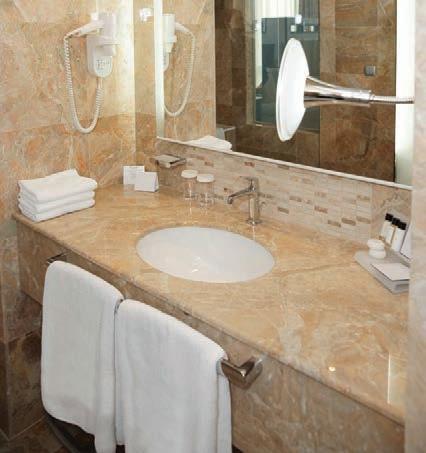
10 Distribution centers across north america hospitality@americandawn.com 800 821 2221 americandawn.com
collection
The gold standard in textiles; including towels, bathrobes & slippers, sheets & blankets, basic bedding, table linen and apparel. Deep inventories. Immediate Shipping.

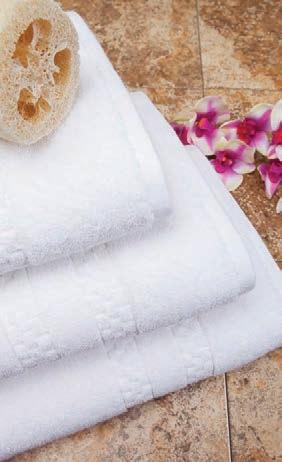


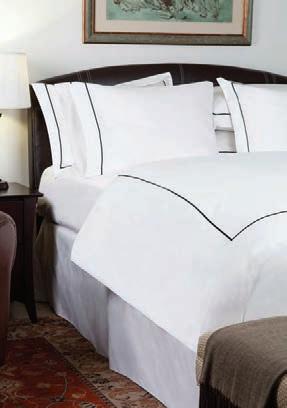



Made In USA Signature Plus™ fabric outperforms all challengers in elegance, soft touch, color consistency and soil/stain release. American Dawn and Milliken... setting the standard of table linen excellence.



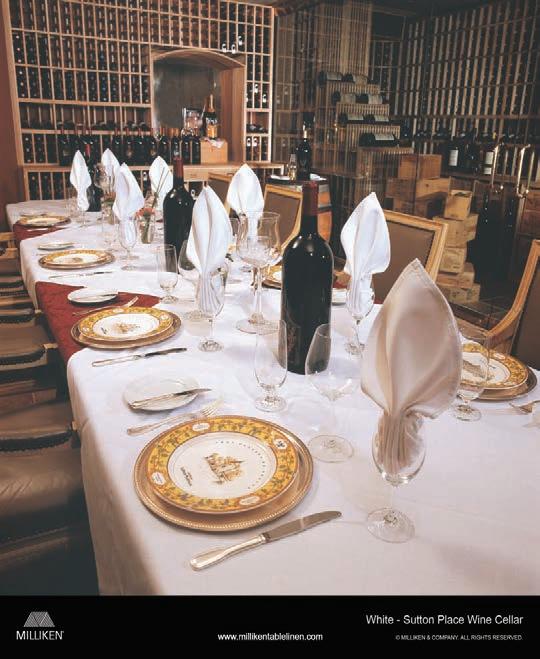
Tools f the Trade
New bleaching product features low-pH oxidizing agent
Laundrylux has introduced PLUS — a new “pay-as-you-use” system for on-premises laundry operations. According to the company, customers utilizing PLUS receive high-quality laundry processing with Electrolux Professional washers and dryers — with no capital investment in equipment. Parts and service are included. The program is suited for a wide range of facilities.
PLUS—an acronym for Professional Laundry Utility Service—is reimbursable by Medicare.
As part of this service, all the equipment is delivered to the laundry room at no charge to the cus-

Meese Orbitron Dunne (MOD) has unveiled its 2014 “Laundry Carts, Trucks and Baskets” product brochure. Updated with the company’s latest innovations, the new laundry literature features the P-433 and P-291 Biohazard bulk forklift containers that earned U.N. 11H2 certification and DOT approval for safely handling infectious medical waste, soiled shop towels and other hazardous materials. The 101P series of bulk linen trucks sport the company’s signature, nonremovable shelf system, which maximizes
The new Fossfill 2® pillow from JS Fiber includes a new sanitizing treatment called UltraFresh®.
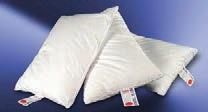
According to the company, the treatment inhibits the growth of bacteria, fungi and other organisms, ultimately keeping pillows fresh and clean. Fossfill 2 pillows also have antibacterial FossGuard™ protection, which helps protect against dust mites, mold and mildew.
“I’m very excited to bring the Fossfill 2 pillow into the forefront again,” says Morris Long, CEO and president. “The addition of Ultra-Fresh has made
tomer. It includes all parts and labor. Customers pay a fixed charge per cycle to use the washers and dryers; they only pay for what they actually use. There is no lease or long-term contract, Laundrylux says. Usage is tracked electronically, and then billed automatically. With PLUS, laundering becomes a utility service, just like water, gas, and electricity. Like any utility, the facility pays for PLUS only when it uses it – with no long-term obligation, the company says.
www.laundrylux.com 866-575-1010
Diamond Chemical Co. has introduced Diamond Brite™, a low-pH oxidizing agent.





According to the formulator, the new product will enable the launderer to achieve lower costs by reducing water use and temperature. It is also said to reduce stain/rejects, and lowers TDS, thereby delivering softer textiles and provides for lower
alkali use and lowerpH washing. Use of Diamond Brite creates a gentler washing environment, and is also safe on colors and improves color retention and textile life, says the company.
www.diamondchem.com 201-935-4300
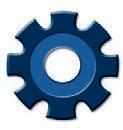
Sports laundry detergent meets cleaning needs of active athletes
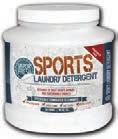
use of available space, MOD says. According to the company, the product guide provides a spotlight on ergonomic carts and trucks, which are designed to reduce bending, reaching and lifting, and explains the advantages of each type of spring-loading option. A wide range of the company’s rotomolded laundry carts, sorting tables and accessories is also profiled.

www.modlaundry.com 800-829-4535
Raw Athletics has introduced a new sports laundry detergent specifically formulated for performance sports apparel. The new soap has been added to the company’s Vapor Fresh® line of sports cleaning supplies.
According to the formulator, the technology in the new Vapor Fresh Sports Laundry Detergent is performance-driven,
with a focus on removing body oils and sportspecific soils from performance fabrics.
It’s also a powder detergent, specifically formulated for cold wash, and is completely free of fabric softeners, artificial fragrances and optical brighteners.
www.rawathletics.com 888-619-0729
a great pillow that was already washable, refluffable and nonallergenic even better.”
Fossfill 2 is a patented natural synthetic polyolefin film, which is thin, irregularly shredded and then exploded in a conversion process to simulate the light, fluffy quality of down, JS Fiber says. But unlike down, the pillow will fluff up like new, and is 100% hypoallergenic, according to the company. It also is said to have enhanced washability and durability.
www.jsfiber.com 704-871-1582
Kaeser Compressors has redesigned its BSD rotary screw compressors series. Available in 40-, 50-, and 60 hp with flows from 157 to 294 cfm and pressures to 217 psig, the new compressors deliver “builtfor-a-lifetime” reliability, simple maintenance and sustainable energy savings, the company says.



Kaeser says it has further enhanced the BSD series’ energy
efficiency through a combination of true direct-drive design, premium efficiency motors, lower internal pressure differential, and optimized airends. Power is said to be improved by up to 6%. In addition, built-in heat recovery options boost the energy-savings potential.
www.kaeser.com 877-586-2691
8 January 2014 | american Laundry news www.AmericanLaundryNews.com
Distributor introduces ‘pay-as-you-use’ system for on-premises laundry operations
2014 catalog showcases latest carts, trucks, containers for safe, secure, sanitary handling
Pillow designed for hospitality establishments adds new sanitizing treatment, other features
All of the pieces are in place. The best just got even better. We have now strategically partnered with HBD Construction, who is committed to delivering quality and integrity on every construction project, from conception to completion and FV Consulting, Inc., the efficiency specialist for your lean process improvements. We are now the one and only laundry service company in North America to offer full services from building construction through to plantoperations and support. Building Smarter Laundries for Smarter Operators 978.373.1883 | www.eomech.com
Redesigned rotary screw compressor built for reliability, sustainability
David Mertens Sr. VP Operations ALS PUZZLE AD_Layout 1 5/15/13 3:20 PM Page 1 ALN_Tab_1-4_H.indd 1 5/15/13 2:40 PM
Gerard
O’Neill President/CEO
Man does not live by print alone.
(Nor woman either.) American Laundry News can now be viewed on tablets and other mobile devices – great ways to stay on top of the latest industry news and updates. www.americanlaundrynews.com

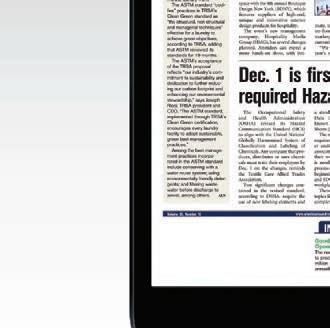



The Newspaper of Record for Laundry & Linen Management
2014 group ready to tackle industry issues


My career started in my father’s plant, on weekends, at the age of 8 years old. My older brother, Jimmy, and I were supposed to be pulling pockets to remove pens, etc., from ruining garments on the drycleaning side. We were less than enthusiastic, and fooled around with the water spray guns on the press machines. Dad got our attention and started pulling the pockets with us. After two or three minutes, he palmed a $10 bill, making us think that it was in the pocket that he pulled. The lesson was “stay focused” on the job you’re doing.
Dad and Jimmy would teach me common sense, logic and analytics. Dad died in 1966, leaving us his shares of the business. Jimmy and I continued to operate the family business until I left in 1980 to become a single dad and start Technical Consulting.
In the beginning, our primary focus was in the operations and production of commercial laundries. We quickly diversified into washroom chemistry, tunnel systems and product development.
Technical Consulting Associates LLC is now the platform for two other companies. Test Master Test Swatch makes a one-time test piece that’s self-reading. The Fabric Testing Co. provides full laboratory services to test fabric life expectancy and analyze damage.
We hold co-patents on the Milnor PulseFlow machine, and Gurtler MagiClens, and other present and past products under license agreements or sold outright. I have been qualified as an expert in the laundry industry in most courts of jurisdiction, including federal.
Our most memorable accomplishment of 2013 is the introduction and marketing of MagiClens by Gurter Indistries.
The most complex thing we face in the coming year is maintaining our independence! As our client base continues to grow, we
find that it’s more difficult to prevent the appearance of a conflict of interest. Clients such as 3M, GE Capital and The Mayo Clinic, to name a few, require absolute credibility. If you represent a client correctly, you must bring forth facts and evidence that may require the placement of responsibility, which is always difficult, but necessary!
spa, and sanitizing products, programs and equipment.
It is an honor to be selected for this Panel to represent the Chemicals Supply segment. I hope my experiences will provide a value and insight in the upcoming Panel of Expert discussions.
tions of housekeeping and laundry services. We also have a partnership with the local high school for its special education class; my colleagues and I come each week and perform laundry duties to help introduce these students to the workforce upon graduation.
The biggest challenge I face is linen utilization and distribution. Theft and abuse is a common factor at any resort. Trying to perform constant inventories has helped, but it does not curb the problem 100%.
I look forward to the new year, and wish all continued success for 2014.
Ihave been in the laundry industry for almost 23 years. My current position, principal technical support specialist for Ecolab’s Textile Care Division, offers me the opportunity to provide technical support to all the laundry market segments, including industrial, healthcare and textile rental.
If I’m not on my computer providing help with chemical, quality, regulation microbiological questions, I am in the field working with customers on projects, including new products.
The laundry industry is changing in so many ways, from the way we wash with a goal of conserving water and energy, how production data is collected and managed, handling new textile fabric technologies, regulatory requirements and requirements for personnel safety. The list seems to go on and on. I am excited to be a part of an evolving industry.
Prior to providing technical support to the large laundry market segments, my experiences included laboratory work and field evaluations on numerous industrial wash chemistry projects at the Ecolab Research, Development & Engineering Center. I also have nine years experience in sales. My experience includes sales, consultation, training and technical support for industrial and on-premises laundries, healthcare, hospitality, and commercial market segments, including laundry, housekeeping, floorcare, warewashing, pool and
Ihave been in the hospitality business for 13 years. During that time, I have worked in the operations, housekeeping and laundry divisions. For 10 years, I was at The Greenbrier Resort, a 4 Star, 4 Diamond resort in West Virginia. While there, I studied hotel and tourism management, with a management training program designed specifically for the hospitality industry. I spent seven years in operations, one year in housekeeping, and managed the laundry and valet drycleaning plant for two years. We processed anywhere from 5 to 6 million pounds annually.
I am now the executive housekeeper for The Resort at Glade Springs, in Daniels, W.Va., and have been at this property for more than three years. I manage the laundry department here as well. We process approximately 600,000 to 750,000 pounds annually for the 200-room resort.
I am a member of the Association for Linen Management (ALM). I have attended the association’s American Laundry and Linen College at Eastern Kentucky University, Richmond, Ky., and earned the Registered Laundry and Linen Director (RLLD) designation.
I love to be involved in the community and have built relationships with programs. In 2012, The Resort at Glade Springs was named Employer of the Year by the West Virginia Division of Health and Human Resources, Rehabilitation Division. We hired deaf associates, and trained them to perform the essential job func-
Ihave been working in the facility management industry in various positions for 30 years. I was an environmental services laundry manager for seven years, and for the last seven months I have served as a director.



The first six-plus years of laundry management consisted of overseeing a staff of eight employees in a clean-linen distribution/ soiled-linen pickup operation in an acute care hospital. This facility had a current licensed bed capacity of 727, and an average daily census of 600.
I managed the clean-linen distribution/soiled-linen pickup in a university medical center with more than 40 distribution points. This included oversight of all linen operation reporting responsibilities to the hospital finance department, in addition to managing 42 hospital housekeeping associates and department supply management. The linen areas of responsibility had a total poundage laundered of 2.8 million in 2012.
We partnered with a healthcare-specific local laundry, completing scheduled nursing department rounds, leadership meetings and periodic unannounced laundry plant site visits. In addition, we utilized the hospital’s
infection-prevention inspection resources for these site visits.
As director of environmental services, I currently oversee a full laundry operation, with 1 FTE, in a 60-bed skilled nursing neighborhood within a 200-bed senior living community. My responsibilities also include the management of housekeeping, plant operations and grounds maintenance, with an additional staff of 17, with two supervisors.
Our laundry focus is the attention to detail in the daily laundering and delivery of our residents’ personal clothing. We ensure the correct identification and placement in the individual resident room closets, along with laundering and distributing all bed linen and towels.
Iam the plant manager at Monarch Textile in South Bend, Ind. Monarch is a family-owned and -operated business established more than 50 years ago. I have been the plant manager for more than 10 years, and my duties include managing a staff of 35 production employees on a daily basis.

I monitor production rates and processing of all products, from soil to all outgoing orders.
Monarch delivers in an 80-mile radius of South Bend. We have nine routes, one of which is a dedicated medical route, while the other eight deliver foodand-beverage, dust control and uniforms.
I also have to hire and train employees for a soil room and two wash rooms, three ironing crews, medical processing department, an order-filling department, garment department and dust control. At the same time,
remain mindful of direct labor
in Milliken’s
completed
at
Production 10 JANUARY 2014 | AMeRIcAN LAUNdRY News www.AmericanLaundryNews.com
I must
costs. I have participated
linen care program, and also
three years of training
the TRSA
PANeL of exPeRts
contributors
Our new
introduce themselves, describe their operations, and summarize the challenges facing the segments they represent
consulting services
Technical
Long-term care Laundry Brian Barfoot Aberdeen Village/ Aramark Olathe, Kan. chemicals supply Carrie Armstrong Ecolab Eagan, Minn. Hotel/Motel/ Resort Laundry James Brewster The Resort at Glade Springs Daniels, W.Va. textile/Uniform Rental
Sam Garofalo
Consulting Associates Charlotte, N.C.
Michael Brock
Monarch Textile South Bend, Ind.
Management Institute.
It is also my responsibility to establish and implement departmental policies with management staff. I also track and maintain all production reports for rates on a daily basis, revenue per product on a weekly basis, pieces per pound, revenue per pound, labor per pound, and labor cost per piece. I determine areas need ing cost reduction and program improvements.

Monarch operates out of four different buildings. Plant One features linen and a medical wash room, with 6-roll and 8-roll ironers. It is used for processing all food-and-beverage products.
Plant Two has a 3-roll ironer and dry-fold department. It is used for processing all medical products, with a self-contained medical room. Plant Three consists of the soil, with a medical sorting room, a plant count and DEC separating area. Plant Four is a dust control and garment plant, with an RFID mat-rolling station, garment presses and a garment tunnel.
Today, I oversee all production areas on a daily basis. Every day is a learning experience. I enjoy going to work most days. Yes, I do laundry, but each day is differ ent. There are different products to process, and different orders to send out. And, of course, we always have the last-minute order that customers forget to call in.
dries. I really have received an education from these folks. So, a huge shout-out to those laundry people, from Los Angeles to West Palm Beach, and from Dallas to Albuquerque, with a quick stop over in Tuscaloosa.
I enjoy listening and asking lots of questions. I am extremely honored to be a part of this Panel
me, I can almost guarantee that I will get to your facility as soon as possible and learn from you and your team.
Experts. I often have marveled at the direction my career, and that of my colleagues, never imagining that we would be in the laundry business.
My career in management actually started when I was working on the college student program with UPS. Then, my service in the military allowed me to become a


healthcare-linen-only laundry operation. HCSC started with eight hospitals that decided to centralize their laundry functions and shut down their individual OPLs. Over these past 43 years, HCSC’s business continued to grow, and in 1993 we became a Subchapter T Cooperative. Today, we service 130 acute care hospitals, several larger and mediumsize nursing homes, surgery centers and many hospital-affiliated ambulatory care centers. Our laundry operations process more


2014 Education Conference

iam the director of government programs for Phoenix Textile Corp., located in O’Fallon, Mo. Prior to joining Phoenix, I man aged a government sales team for a major computer company. I took early retirement from that position, and took my 17 years of knowledge in the government and joined Phoenix Textile, where I have been for the last 14 years.

Coming from 150,000 employ ees to 100 employees was a tre mendous culture shock. But I was privileged to work and learn from the best, Pam Reynolds (founder and CEO of Phoenix), and Gene Rodgers, vice president of operations. I never had been in a laundry until coming to Phoenix. Early on, I spent time in a VA laundry learning about what they do and how they do it. Yes, I got my “bell rung” walking into an overhead moving laundry bag. I will not make that mistake again!
I represent Phoenix Textile’s Government Division to govern ment agencies all over the globe. One of the best things about my position, and all the travel that goes with it, is getting to spend time in some of the VA laun-

www.AmericanLaundryNews.com AmericAn LAundry news | JAnuAry 2014 11
on Page 12
The American Reusable Textile Association F Founded in 1982 OUR MISSION: To create greater appreciation and acceptance for reusable textiles An association representing all facets of the textile maintenance industry: Profit and Not-for-profit Launderers • Management/Consulting Firms • Fiber Producers • Mills • Fabricators • Laundry Equipment Manufacturers • Distributors • Chemical Manufacturers Join Us In Orlando Feb. 26-28! ARTA’s Fifth Education Conference is at the Orlando World Center Marriott Must-attend event for healthcare laundry executives. Register early for discounted rates; discounts for multiple registrations. Optional plant tour of Disney laundry on Feb. 26. Since 1982, ARTA has worked to create greater awareness and demand for reusable medical textiles. We’re the experts on helping you make the case for increasing the use of reusable textiles and surgical textiles. Come join us (and maybe
the
for ARTA’s
Register online now or download registration form and agenda from www.ARTA1.com. Wed., Feb. 26 • 2 p.m. Tour of Disney Laundry Facilities • Welcome Reception by MIP and Encompass Group Thurs., Feb. 27 • What’s New in Textiles, Selling Against Disposables, and the Future of Infection Control • The Long-Term Marketing Approach: Tips on Making the Sale • Sponsor Reception
of our wonderful sponsors! Fri.,
28 • After the Sale: How to Keep and Grow Your Client Base • Afternoon Golf Tourney, must RSVP in advance March 1-2 • Stay the weekend at the Marriott! $189 conference rate available for weekend, first come-first served. ARTA 2014 HOTEL RESERVATIONS $189 per room night Orlando World Center Marriott Resort (Near Disney and attractions) 8701 World Center Dr. • Orlando, FL 32821 407-239-4200 (ask for ARTA room block) NEED MORE INFO? Contact Nancy Jenkins at njenkins@arta1.com. 2014 Education Conference Registration Fees Go to to download an agenda and registration forms. Early Registration by Feb. 5 Full Registration MEMBER FEES • Early-Bird $595; 2nd and additional are $495 $695; $595 NON-MEMBER FEES • Early-Bird $695; 2nd and additional are $595 $795; $695 OTHER Student Registration $275 Spouse/Guest Fee $150 (includes lunch and reception on Feb. 27) You can register online at www.arta1.com or mail your check to: ARTA, PO Box 1142, Mission, KS 66222. Online purchases include a transaction fee. Multiple registration discounts are not available online at this time (but we are working on it, so check the website if you are interested in this option). NJ rev.0114aln_ARTA.indd 1 11/8/13 11:32 AM
bring
family),
Fifth Education Conference. Agenda Overview
courtesy
Feb.
Textiles
Hal Herweck Phoenix Textile Corp. O’Fallon, Mo. HCSC
Healthcare Laundry Michael Kirsch, CLLM
Laundry Allentown, Pa.
than 115 million pounds of linen annually, and our service region encompasses a five-state region of the Northeast.

My career started at HCSC laundry as a tractor-trailer delivery driver. I found the linen and laundry business fascinating. Until then, I never really thought about hospital linens and their importance regarding direct patient care. Being the low man in senior-
ity, my run started at 1:30 a.m., and I was servicing a rather large hospital more than two hours away in North Jersey, near the George Washington Bridge. Back then, it seemed as if all the snowstorms started at midnight. It wasn’t long before I realized that my delivery of clean linen was not only important to my customer, it was important to the caregivers and their patients.
Within a year, my career at HCSC found me on the production management team. From there I ventured into customer service as an account representative. Eventually, I took over
responsibility as the on-site linen manager at a two-hospital system, of which one was a 600-bed, Level I trauma center. Once I was working on-site, my enthusiasm for linen cost containment and loss prevention grew.
I saw all the waste of linen in healthcare as opportunity. Using coupons clipped out of the Sunday paper as my comparison with bath towel or sheet pricing, I began chipping away at every savings opportunity. Within that year, we managed to cut the trauma center’s linen cost by $400,000. I thought, “This is really fun and totally gratifying at the
same time.” Eventually, HCSC created a new title for me: linen cost containment coordinator.




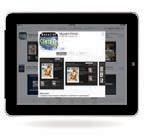
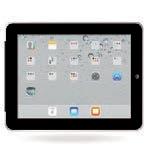



I was eventually promoted to the director of account relations at HCSC, managing 19 service representatives who are responsible for more than 450 healthcare billing accounts. A CLLM certification and Six Sigma degree have been extremely helpful in this laundry business world.
In a few words, “I love my job.” How many people in business can actually say that? Now, at 65, I know my career will end soon, but hopefully we who contribute to this publication’s Panel of





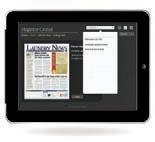
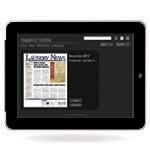
Experts can somehow influence the up-and-coming younger generation of laundry men and women with the passion it takes to not only be successful in this business, but to embrace the challenges and enjoy the work. Over these past several years, I have had the unique opportunity to be a presenter at many national and international educational conferences. It’s a great business, with many great industry leaders.
Thank you for this opportunity.
Irepresent the third generation in my family’s laundry equipment business, and it will be my pleasure to join this esteemed panel and share my knowledge and experiences in the industry.
As a principal of Garment Machinery Co., I’ve done it all, selling and servicing on-premises laundries and Laundromats all over New England. Our business focuses on having the best customer service. We offer clients maintenance on all makes and models of machinery, and we continue to support dynamic, fast-paced organizations within the commercial laundry industry. Through my experiences in sales and marketing, I have learned at the end of the day that we are all in the customer service and customer satisfaction business. As such, our common goal must be to ensure end-user satisfaction.
As a team-builder and largemarket distributor of high-end laundry equipment, my success is determined by my ability to create equipment sales and service opportunities via constant effort and a focused marketing plan. Turning in-depth consumer analysis into actionable marketing plans is critical to a company’s, or an individual’s, success in this industry. I look forward to sharing the highs and lows I have experienced in this business with the 2014 Panel.
One major challenge facing those in the laundry industry is climbing utility costs. At Garment Machinery Co., we recognize we can’t change what utility companies charge for power. However, we can help to ensure that our clients operate at peak efficiency. This industry-wide issue led me to personally help develop an aftermarket residual moisture control device for commercial dryers. This device works in both the coin and on-premises laundry markets, as it detects when clothes are completely dry and instantly shuts the machine down. Stores that have installed this affordable plug-and-play regulator on their
capture an annual util12 JANUARY 2014 | AmeRIcAN LAUNdRY News www.AmericanLaundryNews.com experts continued from Page 11
machines
equipment/ supply distribution
Justin Oriel
Download Magazine Central and read American Laundry News on your iPad or Android Tablet Step 1: Go to your App Store and type Magazine Central into search bar Step 5: Click Download Step 3: Open the Magazine Central App Step 2: Click the box to install the app (you won’t have to do this again) Step 6: Click View Step 4: Type American Laundry News into the search bar Step 7: Read & enjoy! The app stays on your tablet. Check back monthly to download the latest issue. 0114aln_MagCentral_jrpage.indd 1 12/9/13 12:56 PM
Garment Machinery Co. Needham, Mass.
ity savings of $8,000 for a typical 50-pocket store.






There’s a great deal within our industry that remains consistent from one year to the next, but at my company I take my role as leader and innovator seriously, always encouraging my team to look beyond the safety of the status quo and anticipate the evolving needs of our customers.
By identifying current business opportunities that will positively impact the bottom line for the organizations with which we work, we are able to make an impact that translates into positive changes for the end-user.
The daily challenges I encounter in my principal role at my firm were encountered by the two generations that preceded me, and will be encountered by the generation that succeeds me. As an industry leader, I embrace the responsibility of marrying the optimal customer service that helped to build the business with the technological innovations that have evolved over time, and which assist our company in being more efficient through customer-oriented adaptations, communications and analytics.
OPL and commercial side, gave me a communication base of friends and associates that has grown to this day.
For the last 22 years, I have had the great fortune to be part of the G.A. Braun team, I started my career with Braun as regional sales manager, covering the states of New York, New Jersey and Pennsylvania. I also supported various other territories over the years. For the last five years, I have held the position of regional vice president sales, Eastern region. I manage three of our regional territories in the United States, as well as an area in Canada
from Manitoba east. Braun has enabled me to have countless opportunities in our industry, from gaining experience on full plant development and design to being involved on the Healthcare Committee of TRSA for about the last 10 years.
I have been privileged to be part of the G.A. Braun team for the last two decades, and am excited to be part of the ALN team in 2014. While I may author the various answers I submit this year, the information comes from those associates, co-workers and friends I have come to know and respect over the last 30 years. ALN

•
•
•
•
•
•
•
•
•

Iam honored to be part of the 2014 ALN Panel of Experts. With 33 years in our fine industry, the last 22 years with G.A. Braun, I have been fortunate to know and work with some of the best in our industry.
Starting out in the laundry industry around 1980, I took a position with Custom Management. This was a small management company out of my hometown area of Wilkes-Barre, Pa. I worked for Custom for two years, managing housekeeping and laundry departments in Pennsylvania, New Jersey and Buffalo, N.Y., where I still reside today.
In Buffalo, I was fortunate to accept a position as director of laundry for what is now the Catholic Health System of Western New York. It is in this position my knowledge of plant operations had the most growth. We processed approximately 6 million pounds of linen per year for two of the system’s hospitals. Being in the director’s position for nine years, I was able to become involved with NAILM [now the Association for Linen Management, or ALM]. In addition to co-founding the Finger Lakes Association of Institutional Laundry Managers, and securing my CLM, the conferences and networking afforded to me through NAILM, both on the

www.AmericanLaundryNews.com AmerIcAn LAundry news | JAnuAry 2014 13 ALN_Jr Page.indd 1 11/21/13 12:47 PM
equipment manufacturing
Gary Ostrum G.A. Braun Syracuse, N.Y.
American Laundry news Thanks members of the 2013 Panel of experts for Their contributions
Bill Bell, Steiner-Atlantic Corp.
David Bernstein, Turn-Key Industrial Engineering Services
Philip Bodner, Metro-Chem
Steve Hieptas, Maytag Commercial Laundry
Charles Loelius, The Pierre New York
Judy Murphy, North Mississippi Medical Center
Tom Peplinski, Golden West
The magazine welcomes back two 2013 Panel members who have agreed to serve on the Panel again in 2014:
Scott Delin, Superior Uniform Group
Richard Warren, Linen King
Plant design: Getting back to basics
comPiLed bY mike schwANz
sooner or later, many of our readers will be involved in either expanding their existing facilities, or constructing a new laundry plant from scratch. To give you a head start on such a project, we recently invited some laundry design experts to respond to some of the significant challenges that a laundry manager may face in this area.
Identify the key personnel who should be involved in the plant design process.
Ed Kwasnick: First, the management team needs to be involved in the initial planning phase. These are the end-users – the folks managing the production process, loading and unloading delivery vehicles, performing route check-in, answering customer calls. This is the team that will be working in the new plant. With their input and feedback, the plant design can be customized to meet their needs.
Once you have assembled the end-users, then you need somebody who can guide the team down the proper design path and facilitate the design process. This design facilitator can be a preferred equipment provider, a design/build contractor with laundry expertise or a laundry consultant. Regardless, facilitators need to have in-house design expertise, extensive design experience and a track record of success. They need to develop an efficient design that is cost-effective from both an operations and capital investment perspective. However, they also need to “keep the ball rolling” during the design phase to ensure the design is done in a timely manner.
David Chadsey: Everyone involved in the supply, imple-
mentation and operation of the laundry should be involved in the design process. Every project needs a leader, someone to keep the train on the rails. But too often, laundries are designed by a vendor, consultant or manager without the benefit of insight from all parties.
Although a qualified in-house or independent consultant might be the best coordinator, at some point the project should have review from finance, senior laundry management, plant engineering, laundry supervisors, the chemical representative, equipment vendors and construction.
Going forward with a project without input from a wide range of specialists can result in poor design or a gold-plated plant that gets chopped by finance at the 11th hour.
Bob Corfield: The plant owners or key stakeholders should agree and be present for the design goals and long-term vision of what the plant needs to accomplish in both output and financial performance. They should sign off on the project budget, timelines and projected operating profile to accomplish a viable return. They should set the tone for the expectations for the project for their team.
Plant operations (COO, GM, and production managers) need to be front and center for a critical discussion on what elements the plant will possess to meet the operating and performance goals. Their input in workflow, automation tolerances, packaging and benchmarking will be invaluable.
Engineering and maintenance needs a full buy-in on their ability to support the design and systems being considered. They also need to advise their service requirements, space and access needed to perform service and input into technologies being considered.
Meet the laundry design experts
DaviD ChaDsEy
Managing Director
Laundry-Consulting.com Winter Haven, Fla.
BoB CorfiElD
President
Laundry Design Group Phoenix, Ariz.
ED KwasniCK
Director of Business Development
ARCO/Murray National Construction Co. Oakbrook Terrace, Ill.
MEEraj MEhta
Project Engineer
American Laundry Systems Haverhill, Mass.
Meeraj Mehta : Besides the owner, a high-ranking person from the operations department should be involved; that person usually oversees both the production and maintenance departments. His input will be critical since they will be running the plant and living with the design for the lifetime of the plant.
The key to a successful design is excellent workflow between every department, which minimizes the
product handling, and allows good access to equipment for schedule and preventive maintenance. Once the design is finalized, people from the safety and human resources departments should be involved; they will help with proper egress plans, ensuring there are enough bathrooms and water fountains spread throughout the plant, (and) better access to PPE and other safety equipment in case of emergency.
If the question is key personnel involvement on the vendor/supplier side, there is a long list of people from equipment supplier to chemical vendors to industrial engineers.
Describe the average design process, from start to finish.
Chadsey: The best place to start is with an eye on where you want to finish. What is the goal for the area of production or plant as a whole? Many designs are driven by production volumes that need to be met. Others are utility-oriented, with water or energy consumption as primary goals. Labor criteria also can be a core component of the final product. Developing a clear target goal determines all of the following steps.
I worked with a large hospitality organization that thought they needed additional equipment because they were unable to meet production requirements. Initially, their goal was to find a way to fit more equipment into the laundry.
The real goal of increasing production throughput was eventually identified. In our evaluation of the plant, we discovered that the washers were averaging only eight loads per day in 16 hours of production.
The problem turned out to be central to material handling and the production flow through the plant. A change from carts to rail and a revised washer configuration yielded a 40% increase in production throughput with less wash capacity.

With the project’s goals identified, specifications are developed to meet target criteria. Space constraints, budget and timelines can be as significant to a project design as production and efficiency. At each step in the design process, everyone involved should sign off on the progress to date.
Corfield: The following steps should be done:
• Functional assessment of the project needs and requirements.
• Determine the design goals.
• Development of different options for consideration with a high-level budget and possible ROI analysis (retrofit
existing operations, build new facility from existing building, build from greenfield site new construction, etc.).
• Choose an option and refine your budget and project costing based on that decision. Create two to four scenarios (level of expected automation, phased approach or full build models, etc.).
• Get financing approval for the project based on option selected.
Assuming that a site is selected for your project, approvals for utilities are in place, building permits are completely understood and any zoning issues resolved, then: 1) make a working design within the constraints of the financing; 2) develop the production equipment lists; 3) develop the mechanical and process support equipment lists; 4) develop general construction scope of work for plant build; and 5) send the project out for competitive bid for all elements or use negotiated proposal for short vendor lists.
Mehta: Design process starts with a project feasibility study,
which involves making sure the proposed project will satisfy the owner’s objective in a timely manner and is financially feasible. It also takes into account the long-term as well as short-term goals of the project and its impact on existing condition.
The next step is to go ahead with actual design of the laundry, which can start by selecting the right building (for plant retrofit project), or selecting a good piece of property/land where a new building will be built that will house the laundry.
Many factors are considered in selecting the right building or property, such as current and future plant processing volume, budget, long-term plans, availability of all the utilities (water, sewer, electric and natural gas), availability of manpower, accessibility to right marketplace for short-term and long-term growth, logistics (access to major highways, etc.), type of laundry that will be processed, type of equipment that will be housed, etc.
Once the building/property is selected, the next step is to do a detailed equipment layout and

14 JANUARY 2014 | AmeRicAN LAUNdRY News www.AmericanLaundryNews.com
A central energy management and control system helps identify issues and errors, automatically reports to management, and also has the ability to self-adjust based on changing production needs. (Photo: American Laundry Systems)
An extra-wide press with a shuttle system maximizes moisture extraction and provides flexibility in a multi-tunnel washer system plant. (Photo: American Laundry Systems)
workflow design. Make sure all the equipment is in the right place, the laundry is moving efficiently between different departments, and the people working have a safe, productive work environment.
The process now moves from design to RFP process, where equipment and construction vendors are selected based on many variable factors, contracts are negotiated and the budget is finalized. The next step of the process involves actual construction or retrofit of the building, equipment installation, mechanical/electrical infrastructure setup and final utility connection.
The final step to this process is equipment start-up, commissioning, people training and follow-up visits during the warranty period to ensure performance guarantees are met and designed plant is meeting or exceeding everyone’s expectation.
Kwasnick: The process starts with a design kickoff meeting. The purpose of this meeting is to define the design criteria – plant capacity, product mix, equipment preferences, level of automation, site constraints, etc.
The next step is to develop a preliminary design based on the information collected and reviewed during the kickoff meeting. You review the preliminary design with the team and solicit their feedback. Then you develop a final design based on the team’s feedback and desired changes.

The final design is reviewed with the team, and final revisions are made based on the team’s comments.

During each phase, you are honing the design, making it more efficient, more effective and more customized for the end-users’ needs. Once the final design is complete, you provide that information to the project architects and engineers so they can develop permit drawings for the project. These drawings are then submitted to the local building department for review and final approval.
What are the areas in which the most common design mistakes may be made?






Corfield: Well before design, budgeting or utility planning mistakes are the most common planning mistakes. But within design, I have seen a lack of understanding on how to best utilize monorail storage systems and, most critically, integration between systems in relation to automation.
Both of these mistakes can be fatal to achieving production and subsequently the financial goals of a project. Choosing a highly productive tunnel system that requires two batches for dryer loading efficiency, and is matched to a soil monorail system with limited bag pairing, can impair
plant productivity and efficiency. Fixing this issue after start-up is very expensive.
Mehta: One of the most common design mistakes made is in the area of future growth capacity of the new plant. An inexperienced laundry designer, or even many operators, cannot foresee how much growth and how much flexibility should be planned in the plant design.
The future growth has to be calculated and designed for every area of the plant. For example, just keeping space for a future tunnel washer system in a plant is not
going to take care of future growth. Associated finishing equipment such as ironers, small-piece folders or garment finishers also must be accounted for, or else the workflow will not be balanced. The materialhandling system such as monorail or sort system also must be sized to handle additional volume.
designed to ensure it will support future equipment addition.

ALN_Jr Page 9/14/11 12:53 PM Page 1

The mechanical infrastructure should be sized to ensure there is enough water, steam, air, and gas available to support future equipment, and also to make them work efficiently. Process water pumps, steam boilers, wastewater treatment system, and utility pipe header sizing all must be properly
Another example is related to flexibility of the future plant. Take, for example, healthcare laundry. The future of healthcare is moving from bulk healthcare accounts to what we call “medical retail” business. The days of shipping a semi trailer full of laundry products to a big brick-and-mortar building are steadily diminishing. There is a big difference in how the bulk healthcare laundry products are processed and delivered to the customer, compared to the new medical retail clients. A new laundry plant design must account for
these changes and must have flexibility to make the switch/change based on a changing marketplace or customer requirements.
www.AmericanLaundryNews.com AmericAn LAundry news | JAnuAry 2014 15
Kwasnick: One of the most common mistakes I see is leaving inadequate space for soil receiving and clean shipping. Carts, soil bags and slings require space – whether on the floor or in the air. The inability to store soil products in an efficient, effective manner at the beginning of the production process causes bottlenecks that slow down the entire . See DESIGN on Page 16
design
plant. Inadequate space in clean storage at the end of the process can cause its own set of problems, including inefficient packout, prolonged vehicle load times and even loading errors.
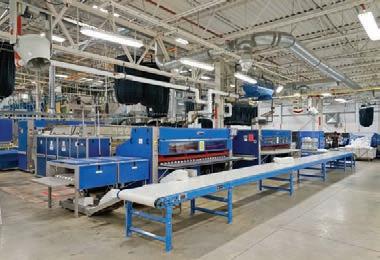


Other design errors include insufficient space around equipment for proper maintenance access, not providing designated aisles (for employees to easily and safely access break rooms, rest rooms, equipment, and exits), providing inadequate space and planning for future growth.
Chadsey: In my nearly 30 years in the industry, the most significant design mistake I see is in compatibility between machines within the plant. It is not uncommon to see dryers paired with wash loads that are not compatible. Although you can process 200 pounds of goods in a 400-pound dryer, there is a better way.
Incompatible machines increase the cost of labor and utilities and result in reduced production throughput.
The components in a flatwork line also should be productioncompatible. It doesn’t matter how fast an ironer can process if you can’t get the goods fed in at the same rate.
I had a client that wanted to improve flatwork production rate by speeding up the ironer. The thermal ironer could have delivered another 20 feet per minute. However, the feeder on the line was already gapping the sheets 15 to 20 inches. The only solution to increase production was a compatible high-production spreader/feeder that could match the speed of the ironer.
What are the differences between original plant design
and an existing plant design?
Mehta: This is a classic example of a below-par designed plant and poor prediction of future needs. The original plant design is what the plant was supposed to do when running at full capacity. It had a certain amount of equipment, certain workflow and certain performance requirements that were factored in at the time of design.
The existing plant design is the plant that is changed to meet today’s needs. The workflow is nonexistent, the performance criteria are thrown out the window, and equipment has been added, removed, relocated and altered to meet current needs. It’s a bandage that will keep the plant operating and meeting customer needs for the time being. It’s a reaction to changing needs rather than a well-thought-out solution.
Kwasnick: The biggest differ-
ence is a new plant design can be customized to meet the exact needs of the end-user, while converting an existing building into a new laundry always requires some level of compromise.
An existing building may have ceilings that are lower than desired, delivery vehicle access on only one side, or the column spacing is narrow in one or both directions. You must modify the design to accommodate these existing conditions, which may impact the efficiency, productivity and capital cost of the project.
A build-to-suit plant design does not begin with any preexisting building conditions. It’s a blank page that can be molded to meet the exact needs of the customer. Offices can be located on the ground floor, on a second floor or both. Main utilities can be designed to enter the building at any point that is deemed best.
Production flow can be U-shaped, L-shaped or straight line, depending on the wants, needs and preferences of the end-user.
Chadsey: My wife and I like to watch the popular HGTV show Love It or List It. Every week, Fergus seems to encounter some budget-busting change that was hidden in the wall. Instead of getting their dream kitchen, the client ends up with a sump pump in the basement.
Existing plant design for large projects can have similar problems. This is where a team of laundry experts really can help in identifying all of the contingencies before going forward.

New plants can be more difficult to visualize for some clients. It is easier to show in an existing plant that a certain production area is going to be 50% larger. In a new plant design, understanding what 40,000 square feet looks like and why it is so important to have open staging space within the design is difficult for some to comprehend, especially those not involved in day-to-day laundry operations.
Corfield: Original concept vs. as-built-and-operating occurs when designs are modified after the plant is running a short period. When I have seen this, it has been the result an underperforming system or very poor functional assessment phase of the design process.
Years ago, a healthcare plant was built with a cart wash system designed for 250 carts per day, but in reality the system could not reliably achieve that demand week in and out. No other vendors would agree to the production standard. The vendor chosen could not meet the demand specified. Therefore, the system was taken out and replaced with a manual system, thus impacting labor, workflow and costs. The cart system was crippling the plant’s ability to meet daily demand.
What are the key budget factors that often are underestimated?
Kwasnick: Here’s my list of items that are very often underestimated or missed completely:
• Utility impact fees.
• Architecture and engineering design.
• Interior and exterior building work not directly related to the laundry process (i.e. roof repairs, fire sprinkler system, outdoor signage, landscaping, paving repairs, painting, carpet, drop ceiling, lighting, etc.).
• Making an existing building ADA-compliant. Includes retrofitting building access and rest rooms.
• Process piping and electrical work related to the equipment (i.e. steam, compressed air, water, natural gas, etc.).
• Control wiring: Today’s automated laundry equipment requires more control wiring between systems as well as runs to central computers in the office.
• Production floor coating or diamond polishing.
• Carts: They are more expensive than people think.
• Man lift: Most new plants need a lift to access rail systems, overhead piping, lint fans, etc.
Chadsey: A well-planned facility is one that takes into account all of the key budget figures. This ties back to the question of who should be involved. Construction will know their numbers, equipment professionals will know theirs, and operations people will understand what outsourcing may be required. Having a deep team and not relying too heavily on one source will minimize the bad surprises that can result from underestimated budget factors.
The period of time between start-up and full production sometimes seems to take longer than anticipated. Vendors should be given the required time to meet their scope requirements, then held accountable to meet the schedule.
Corfield: Whether you are building a new plant or retrofitting an existing plant or building, construction costs and utility timelines and fees are grossly underestimated. When poor budgeting occurs, two things are affected:
1. If the project proceeds and no further funding is allocated for the newly discovered project costs. Therefore, compromises are made in construction and equipment selection to accommodate the loss in funding. This can have a dramatic impact on plant financial performance.
2. Confidence in the management team that made the mistake is often unrecoverable. I have seen key managers depart projects following the discovery of such planning and budgeting mistakes.
16 January 2014 | american Laundry news www.AmericanLaundryNews.com
ALN
continued from Page 15
The extensive monorail system in the Zischka Textile plant near Frankfurt, Germany, demonstrates an excellent use of material handling. The plant has a primary focus on healthcare and hotel work. (Photo: Laundry Design Group)
Good design requires the involvement of many specialties. Chemical suppliers should be on board to confirm appropriate location, square footage and utility requirements for dispensing equipment. (Photo: Laundry-Consulting.com)
The ironing department in the Hospital Laundry Services plant in Fort Wayne, Ind., was redesigned and expanded. Additional ironing equipment was added to increase the overall finishing capacity of the plant. (Photo: ARCO/Murray)
The E-Tech load-on-rail soil sort system at Hospital Laundry Services features a new section that uses the latest load-on-rail technology to sort the high-volume soil products. (Photo: ARCO/Murray)
good clinical outcomes.”
Meeting deadlines is vital. “Another quality responsibility is timely processing,” adds Williams. “You need to have agreed-upon turnaround time with your customers, and you need to follow and produce that turnaround time.”
PERFECTING PROCEDURES
Items such as surgical adhesives and other disposable objects can get mixed in with the linen, says Williams. She advises to check scrubs, lab coats and uniform pockets to remove such objects to ensure cleanliness.
“As laundry people, you’re probably thinking … the healthcare facility is responsible [for this], and I do agree with you,” she says. “However, if they do not adhere to their responsibilities, then you need to take on that responsibility in your laundry.”
Also, look at the appearance of properly folded and hung linen that will appear to your customers to represent cleanliness and neatness.

“In the packing and transport, you need to make sure that
the linen is covered … and that soiled-linen collection carts are put through a cart wash as needed.”
Other responsibilities, such as inspecting linen for visible stains, holes and tears, are par for the course. But Williams adds that other processes that may not necessarily be standard procedure are important, as well.
“If you provide a surgical program and process surgical linen, you may be responsible for inspection of those surgical products,” she says, adding that such tasks would include folding linen according to the doctors’ and nurses’ recommendations; patching; assuring barrier quality of surgical linens; and discarding linens that are no longer useful.
For laundry facilities that process surgical linens, Williams also stressed the importance of documenting cleanliness standards. “Inspect each item carefully. When it comes to surgical products, it’s even more critical than patient floor procedures.”
She highlighted best practices, such as utilizing overhead lighting to inspect linens for lint and stains, and barrier testing in processing surgical products. “Even if the product has not reached its life expectancy and cycle, it is possible that the barrier quality has been compromised if the wrong laundering procedures are used,” says
Williams. “Barrier tests of some products should be done randomly, preferably on a daily basis.”
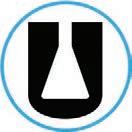
FACILITY’S ROLE
Linen responsibilities lie not only with the laundry but with the healthcare facility as well, according to Williams. “If the healthcare facility owns the linen, then it’s their responsibility to purchase the proper quality of linen,” she says. “Poor-quality products produce poor results. A laundry cannot be held responsible for the life of an inferior product.”
Healthcare facilities should maintain adequate linen inventory to not only preserve the life of linens, but to attain fill rates, she adds.

Removing non-linen objects from soiled laundry also should be a priority for healthcare facilities, Williams recommends. “The high production in the laundry can’t catch every tape and lead that comes through in that soiled linen.”
And as the “first line of defense,” healthcare facilities also should take part in a linen “reject program” to properly set up standards as to which types of damaged linens can still be deemed acceptable for use.
“One very popular method of culling out unacceptable linen is putting a ‘Clean Unacceptable’ linen bag on the linen carts when they go to the floor,” says Williams. “Linen distribution then collects
that unacceptable linen and can inspect it and rewash or discard as needed.”
CHALLENGES
No process can ever be perfect. On the laundry’s end, customers can have “unrealistic” expectations. “That’s why it’s very important to have a good partnership, good communication to set those expectations together,” says Williams.
She adds that managers should be realistic with staff production goals.
“If you’re a laundry [that] provides incentives to production staff based upon volume, this could cause some quality concerns, because they may be trying to reach their goal and skimp on the quality end.”
And though laundry managers and healthcare facilities may agree on a linen standard they believe is acceptable, patients and their families may think otherwise, which can affect a healthcare facility’s standing in patient surveys such as the Hospital Consumer Assessment of Healthcare Providers and Systems (HCAHPS) survey, and the Press Ganey patient satisfaction survey.
In addition to external challenges, laundries and healthcare facilities can face internal challenges.
“We also have the language barriers in the laundries today, and they can be a challenge,” she says.
“Using visuals can help a lot, in that respect.”
QA OUTCOMES
Adhering to a quality assurance program can have many benefits. Laundries will save time and money by avoiding reprocessing linen, and it can reduce linen loss and mysterious disappearances, leading to not only delighted customers, but customer retention, as well.
For healthcare facilities, utilizing a quality assurance program to ensure linen cleanliness will improve patient scores. “It’s going to enhance your credibility and your image in the marketplace,” she says.

Staff will appreciate the results, too. “If the staff has what they need, when they need it, in a good quality, they don’t have to go searching for linens,” says Williams. “If they have products that are protecting them, [they are] going to be much more satisfied in their jobs, and therefore you can retain those employees.”
Williams stressed that quality is everyone’s responsibility.
“Whether you’re a laundry, whether you’re linen distribution, whether you’re a healthcare facility, everyone has to work together to provide a quality and safe product to your staff and to your patients,” she says. “If you do that, your customers and staff will applaud you.” ALN
For over 50 years U.N.X. INCORPORATED has been involved in the development of products that not only solve quality problems that exist at the moment, but also provide long term benefits to the customer and the environment in which we live. U.N.X. was built on the foundation of improving the industry in which we participate. U.N.X. prides itself on being an industry leader with state-of-the-art products and dispensing equipment, and our plans for the future are extraordinary.
With a Research and Development team second to none, U.N.X. is in a position to provide the industry with the most technologically advanced products and dispensers as possible. U.N.X. INCORPORATED 707EArlingtonBlvd Greenville,NC27858 (252)756 8616 www.unxinc.com ALN_Tab_half 10/9/12 2:40 PM Page 1 See us at the Clean Show • Booth #2502 0513aln_UNX.indd 1 4/26/13 10:48 AM ALN_Tab_half.indd 1 8/6/13 11:38 www.AmericanLaundryNews.com AmericAn LAundry news | JAnuAry 2014 17
continued from Page 1
Quality
Make most of on-premises laundry room space
By BiLL BrOOKs
RIPON, Wis. — Operators of on-premises laundries face constant pressures to optimize the productivity of their OPLs. However, trends driving the growth of industries served by OPLs can make that difficult. These trends result in more laundry to be processed, often without increasing the footprint of the OPL accordingly.
Consider hotels, which have been upgrading both the quality and amount of linens in their guestrooms—pillows, duvets, triple sheeting—as one way to increase customer satisfaction.
In correctional facilities across the country, inmate populations have been pushing occupancy limits. Hospitals are facing reimbursement incentives to keep elderly patients in the hospital longer. Long-term care institutions are adding rooms to meet growing demand from an aging population.
Cleaning laundry is not the primary purpose of any of these enterprises, but it is still an essential part of their operation. When adding space to existing OPLs is not an option, it is in the best interests of these institutions to make sure their laundry square footage is organized and equipped to maximize throughput; save utility, water and labor costs; and produce superior wash results.
More Efficient Equipment Helps
Because changing an existing OPL layout is difficult, the best way to maintain an effective workflow and optimize laundry throughput is to upgrade to more effective and efficient washer-extractors and tumble dryers. (Before making any purchases, be sure the new equipment can fit through the building’s doorways and in the available laundry room space.)
New OPL equipment can offer significant efficiency advantages. For example, a washerextractor with 400 G-force extraction results in maximum water removal from linens, which in turn reduces the time (and utilities) needed to dry those linens. Installing a machine that utilizes unique spray rinse technology also increases OPL efficiency. Eliminating the time needed to repeatedly fill a wash tub for a bath rinse is key; spray rinse technology can decrease cycle rinse times
by up to 12%, while also providing superior rinse result compared to bath rinses alone. (A spray rinse leaves up to 22% less residual wash chemistry in the load.) Newer tumble dryer technologies also can contribute to a more efficient OPL. Sensors within dryer drums pinpoint when the load has reached the predetermined dryness level, saving the labor, utilities and linen wear-and-tear costs that result from overdrying.
How the washer-extractors and tumble dryers are situated in relationship to one another is also important to an optimized OPL workflow. Ideally, wet loads should be able to be removed from the washer and placed directly into the dryer with minimal movement. This means there should be adequate space for laundry carts to be shuttled from one machine to the next. If space is tight, don’t put a table for folding and sorting linens directly across from where this transition occurs.
Another significant factor for a good workflow is ensuring that soiled laundry comes in on one side of the OPL, and leaves, clean, on the other side, with little or no cross-contamination. This is important for all OPLs, especially for those in healthcare facilities.
Advanced Controls Create Edge
Newer control systems can help optimize OPL productivity in many ways:
• Look for washer-extractors and tumble dryers that feature the same control system. This makes training staff easier and helps them quickly program the machines for different types of linen. For example, if towels take the No. 2 program to be washed, the No. 2 program on the tumble dryer will also dry them.
• The best control systems monitor how the equipment is being used—the time between starts and stops, whether the correct wash or dry program is utilized, etc.—and provide reports that let managers see where efficiency can be improved.
• With some control systems, a washerextractor can be loaded at the end of the workday and programmed to process the load just before the next day starts. The load is ready to go into the tumble


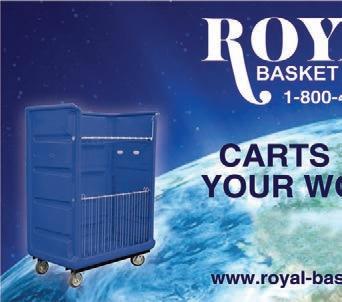
dryer as soon as operators arrive in the morning, and the OPL gets a jump on its workload.
• Advanced controls also provide a time countdown to the end of the cycle so laundry workers know when a load will finish and can be prepared with a cart to transfer the wet laundry to a tumble dryer. Such systems also feature the ability to send text messages or other types of alerts when a load is complete, or even minutes before the cycle ends. These “alert” features allow employees to perform other tasks, such as folding, without having to stop and check if the washer-extractor is done; they also help prevent idle or underutilized equipment.
• In a healthcare facility, the control system on washer-extractors can ensure that linens are washed at a high enough temperature for a specified period of time, and documents in a report that the appropriate sanitizing procedure was followed. This both prevents operator error and avoids time-consuming monitoring and reporting that would have to be done by an individual.
• A good control system also sends alerts when regularly sched-
uled maintenance is required, ensuring that the OPL equipment keeps running smoothly.
Equipment Reliability is Key

Equally important to a well-run OPL as efficient equipment is choosing equipment that is durable and reliable. True OPL equipment should be built to stand up to 24/7 use, year in and year out, even if the OPL does not operate around the clock. No matter how well laid out an on-premises laundry is, if its machines break down or need constant repairs, efficiency goes out the door.
Nothing is less cost-effective than sending an institution’s laundry out to be cleaned while the OPL manager waits for a part that’s on back order. A reputable and knowledgeable distributor can recommend the best equipment for a space-challenged OPL, offer a high level of service and, if a repair is necessary, provide quality replacement parts delivered the next day. ALN
Bill Brooks is the national sales manager for UniMac®, a leading provider of on-premises laundry equipment, based in Ripon, Wis. He can be reached at bill.brooks@alliancels. com or 920-748-4437.

18 January 2014 | american Laundry news www.AmericanLaundryNews.com ALN_Tab_1-4_H.indd 1 7/16/13 3:58 PM
OPL 101
Brooks
(Photo: ©iStockphoto/VCTStyle)
Standard Textile’s Heiman honored with Carl H. Lindner Award
CINCINNATI — Standard Textile President and CEO Gary Heiman was recently presented with the Carl H. Lindner Award for Entrepreneurial and Civic Spirit at the 2013 Deloitte Cincinnati USA 100 luncheon, the company reports.
The annual Deloitte Cincinnati USA 100 list recognizes the achievements of Greater Cincinnati’s largest privately held businesses, the company says, where Standard Textile was recognized as one of the region’s 100 largest privately held companies, and was one of just 14 companies that have been included in the list every year since it was first compiled in 1983.
The Carl H. Lindner Award for Entrepreneurial and Civic Spirit was presented to Heiman for “personifying the leadership, business success and civic involvement that was characterized by Carl Lindner, who made a profound impact on the Cincinnati community,” Standard Textile says.
In 1986, Heiman became president of Standard Textile, which his grandfather, Charles, had founded as a linen distribution company in 1940. Heiman was named CEO in 1994, and the company has since expanded into the hospitality and workwear industry.

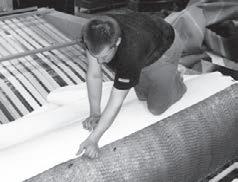

Since undertaking his role as CEO, Heiman established



“the first textile wholly owned foreign enterprise in China,” as well as led Standard Textile to become “the first American company to build a manufacturing facility in Irbid, Jordan,” in 1997, the company says.


Heiman is a member of the board of trustees of the University of Cincinnati, where he also serves as chairman of the Finance and Administration Committee, the company adds. Additionally, he is chairman of the board of trustees of the Jewish Foundation of Cincinnati; former chairman of the Jewish Community Center; a member of the Cincinnati Business Committee; and former chairman of the board of The Jewish Hospital of Cincinnati.
Aramark celebrates IPO on NYSE

NEW YORK — Shares in Philadelphia-based Aramark, provider of food, facilities and uniform services, recently opened for trade on the New York Stock Exchange (NYSE) under the ticker symbol “ARMK” after its initial public offering (IPO), the company reports.

Aramark President and CEO Eric Foss was joined by frontline employees and members of the management team to celebrate the first day of trading by ringing the Opening Bell, the company says, as well as visiting the NYSE trading floor to witness the stock opening and unveiling of the company’s revitalized logo and tagline, “We Dream. We Do.”
“We’re pleased to welcome Aramark to the New York Stock Exchange,” says Scott Cutler, executive vice president and head of Global Listings, NYSE Euronext.
“As a company committed to innovation and providing stellar customer service, Aramark is an excellent addition to the NYSE’s community of leading companies. We congratulate Aramark on its IPO, and are proud to partner with the company as it embarks on its journey as a publicly traded company.”
“The step Aramark is taking today better enables us to fulfill our growth objectives and our mission to ‘Deliver Experiences that Enrich and Nourish Lives,’” says Foss. “As a public company, we are even better positioned to execute our repeatable business model and deliver innovative, highquality services to meet the evolving needs of our clients and customers.”
APRIL Feature:

www.AmericanLaundryNews.com AmericAn LAundry news | JAnuAry 2014 19 IN EVERY ISSUE: • Tools of the Trade • Wire Survey Results • Career Track • Trade Ticker • Panel of Experts • Upcoming Events • Source Directory • Classifieds Want to send a press release or submit a story? Contact Bruce Beggs, editorial director, today! Phone: 312-361-1683 E-mail: bbeggs@americantrademagazines.com DON’T MISS OUT HERE’S WHAT’S COMING UP IN AMERICAN LAUNDRY NEWS... MAY Feature: Chemicals: Choosing Wash Formulas What factors — internal and external — influence the hows and whys of this important skill? Editorial Submission Deadline — March 15 JUNE Feature: Exhibit in Print Don’t pass up this 2-for-1 deal! Your display ad appearing this month also reserves your company a spot in a unique advertisers-only product exhibition. Editorial Submission Deadline — April 15 FEBRUARY Feature: Healthcare Laundering Infection control, the reusables vs. disposables debate, and the impact of “Affordable Care” are among the issues facing this important market segment. Editorial Submission Deadline — December 15 MARCH Feature: Buyer’s Guide Arguably the most complete, widely circulated guide of manufacturers and unique suppliers serving the laundry and linen industry today — a “keeper” for readers and advertisers alike. Editorial Submission Deadline — January
15
Linen Management
Inventory
...and much more! 0114aln_EditCal_JuniorHalf.indd 1 12/12/13 1:54 PM With over 50 years of industry experience, and a long-standing tradition of dedication to customer satisfaction; we guarantee you consistent Savings, Integrity, Efficiency and Expertise. Contact Us! Lubbert Supply Co LLC 626 Surf Ave. Stratford, CT 06615 Phone: 855-922-1705 Fax: 203-690-1107 Email: sales@LubbertSupply.com Web: www.LUBBERTSUPPLY.com Lubbert Supply Co. LLC THE SOURCE for Flatwork Ironer & Finishing Equipment Supplies We stock a full line of Finishing Equipment Supplies: Ironer Pads & Covers Replacement Springs Aprons Belts Lacing Guide Tape Press Pads & Covers Baskets & Liners Bags / Nets / Slings Wax / Cleaning Cloths Family Owned and Operated 0113aln_lubbert.indd 1 12/10/13 11:30 AM
and
Control A manager’s ability to accurately track and protect a linen supply directly impacts the bottom line. Editorial Submission Deadline — February 15
ALN
Aramark President and CEO Eric Foss is at center of the trading crowd as the company’s stock opens for trading on the NYSE.
Heiman
PARTS FOR SALE
WASHEX PARTS



Hard-to-find Washex parts, on-site rebuilding, tech support.
LAUNDRY PARTS CENTER 800-352-4492 Fax: 305-827-3991
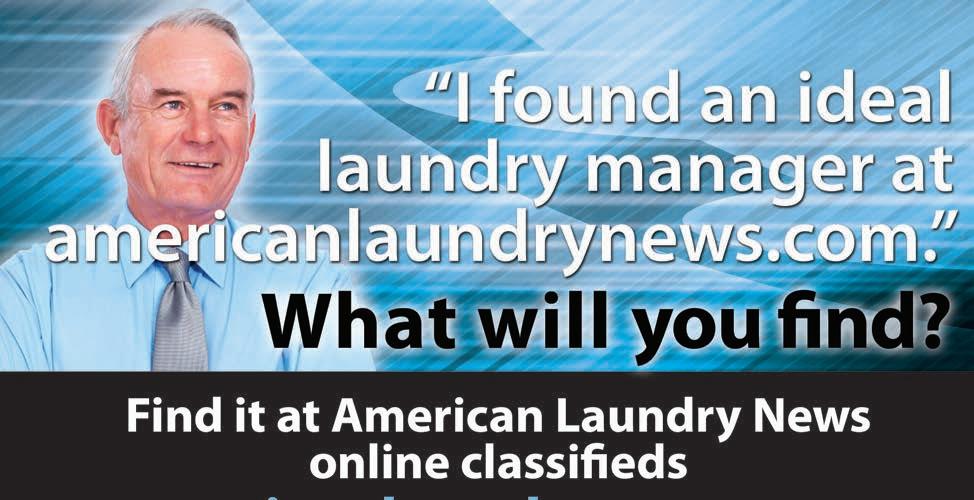


PARTS, PARTS, PARTS
Huge stock of parts for most laundry equipment & boilers. Also traps, valves and lubricants. Overnight delivery.
Steiner-Atlantic, 800-333-8883 Fax: 305-751-8390 parts@steineratlantic.com www.steineratlantic.com

U.N.X. INCORPORATED seeks skilled professionals in the laundry industry to foster new growth and expansion. With 55 years experience in health care, hospitality and industrial operations, we are an industry leader with the most technologically advanced chemical products and “state of the art” injection systems available.
If you have had successful selling experience in high volume laundry plants, come grow & expand with U.N.X.!
Territory Managers will have advancement opportunities. U.N.X. is an equal opportunity employer. To apply, contact us at:
20 JANUARY 2014 | AMERICAN LAUNDRY NEWS www.AmericanLaundryNews.com
Classified
Advertising
EQUIPMENT FOR SALE AMKO AMERICA, INC. Remanufactured Finishing Equipment Delta Ironers, Omega Folders & Towel Folders (1 year parts warranty) Like new at half the cost. PARTS, IRONER SUPPLIES & NEW EQUIPMENT ALSO AVAILABLE Contact: (561) 863-9696 jurgenb@bellsouth.net VISIT www.AmericanLaundryNews.com POSITIONS AVAILABLE POSITIONS AVAILABLE www.ineedjpequipment.com 800/925-3236 EQUIPMENT FOR SALE: 100 GPM DAF System (Installed/Running/ Ready to disconnect) 250lb Braun OP (Complete Reconditioned / Ready to Ship) 400lb Braun OP, Single motor Drive, 1996, Reconditioned, new Inverter, Bearings, Boards, etc (2) 2002 200lb Braun TSL (2) 400lb Brim OP Washer/Extractor (2) 800lb American L-Trons (3) 310lb ADC Steam Dryers (5) 120lb Gas Dryers 8 Mod G3, 90lb CBW (wearable parts replaced), + 3 - 110lb Dryers, 2001, complete system Complete 110lb Milnor Classic Tunnel Systems in stock - Sold “as is” or with New Hardware 2007 Chicago Pik-Quik (3) Chicago Edge Feeders (2) Chicago King Edge Feeders (6) Chicago Skyline Folders w Stacker/ 1996 Chicago Blanket Folder “Expect Excellence” DISTRIBUTOR OFFERINGS Expect excellence from the leader in used industrial laundry equipment sales and installation. Keep up to date with equipment for sale, and the latest industry news by subscribing to our monthly newsletter. Go to www.ineedjpequipment and sign up TODAY! About JP Equipment JP Equipment is a trusted, full-service, used industrial laundry equipment sales and installation company. We pride ourselves on providing unparalleled service, whether you are building a new laundry, Call Craig Lloyd toll free at (877) CWL-LOYD between 9 a.m. – 9 p.m. EST. Please visit www.laundrycareers.com to review current industrial/institutional laundry management openings. ADVANCE YOUR CAREER The Griffin Group, Inc. “Recruitment Specialist” Need to FILL a position? Call Deana Griffin 888-235-2365 www.thegriffingroup.cc deana@thegriffingroup.cc ® Stanco Industries, Inc. Serving The Textile Trades Since 1970 stanco2626@aol.com 800-932-3769 Visit Our Website: www.stancoind.com -------------- Equipment For Sale -------------1993 Braun Delta 3-Roll 32” Steam Ironer 1993 Braun Omega 4-Lane, w/Stkr & Conv. 2-2005 Braun 2-Lane Omega Folders 2001 Chicago Blanket Feeder 2001 Chicago Blanket Folder 2003 Chicago Skyline S20 2002 Chicago King Edge 2007 ADC 170# Gas 2-1997 Milnor 135# w/e EP-Plus BOILERS • WATER HEATERS • CARTS–––“Many items can be viewed in operation” “We buy single items and complete plants” Stanco recycles everything KEEPING IT GREEN SINCE 1970 QTY DESCRIPTION 1 Unipress Vacuum Single Buck Shirt Unity w/Collar Cuff 2 Milnor 120lb Steam Dryers 2006 1 Shaper Steam 12” Ironer by 120 1 Chicago Comet Ironer 2008 1 Wascomat Soft Mount 30lb Washer 1 Wascomat Soft Mount 50lb Washer 2 Milnor 36026V5J 100lb Washers 2004 2 Milnor M122 Gas Dryers 1 Chicago PikQuik 5 ADC333 Gas Coin Dryers 2011 1 Braun Rear Discharge Towel Folder 1 Ipso 75lb Washer 2011 For Pricing call Ron Hirsch 516.938.4300 • 516.315.7426 Hicksville, NY www.directmachinery.com FOR NEW OR USED LAUNDRY EQUIPMENT, DM IS YOUR SOURCE FOR ALL YOUR NEEDS We Buy Used Equipment • Pictures on website
PO BOX 7206 Greenville, NC 27835 Fax: (252) 756‐2764 armstrong@unxinc.com
U.N.X. INCORPORATED
www.unxinc.com












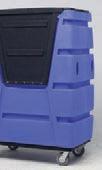














www.AmericanLaundryNews.com AMERICAN LAUNDRY NEWS | JANUARY 2014 21 Source Directory A convenient guide to sources of products and services APPAREL FINISHING CARTS, TRUCKS & BASKETS #1 Manufucturing Source for Laundry Transportation! (800) 634-0555 RBWire.com Energenics Corp., Kartwasher 1470 Don St., Naples, FL 34104 800-944-1711 www.energenics.com Pellerin Milnor Corp. P.O. Box 400, Kenner, LA 70063 504-467-9591, Fax: 504-468-3094 www.milnor.com DRYERS – 100 POUNDS OR MORE Pack 25% More On Same Size Cart Call 800.829.4535 or visit MODLaundry.com for a FREE QUOTE. Premium Quality Casters Included! 72S Meese Orbitron Dunne Co. Stronger design for big payloads, yet lighter tare weight for easy handling. The Best of Both Worlds TURNABOUT TRUCK Simply reposition the chrome plated shelves to convert from a clean linen delivery to a soiled linen bulk transport truck Easy to load - less stooping and bending l-800-275-2436 RepsAvailable8 AM-8 PM (EST) maxi-movers.com Fax: 631-661-8209 •Email:sales@maxi-movers.com The Cart Guys Chm #9522 Turnabout 3" ALN Class. 10/7/13 12:05 P Source Directory listings in American Laundry News are sold on an annual basis at the following rates: All Major Credit Cards Accepted 2014 Listings Regular Boldface All Caps All Caps, Boldface Four Line Listing per Year $820 $1,030 $1,030 $1,090 Display and additional line rates available upon request CART-WASHING SYSTEMS Sani Trux - McClure Industries, Inc. 9051 SE 55th Ave., Portland, OR 97206 800-752-2821 www.mcclureindustries.com, info@mcclureindustries.com M.I.T. POLY-CART 211 CENTRAL PARK WEST, NEW YORK, NY 10024 800-234-7659, FAX: 212-721-9022 WWW.MITPOLYCART.COM CARTS, TRUCKS & BASKETS CARTS, TRUCKS & BASKETS Pellerin Milnor Corp. P.O. Box 400, Kenner, LA 70063 504-467-9591, Fax: 504-468-3094 www.milnor.com DRYERS – 100 POUNDS OR LESS Diversified Plastics, Inc. 1309 Highway 917 West, Latta, SC 29565 800-768-7636, www.dpirotocarts.com E-mail: sales@dpirotocarts.com, Fax: 843-752-7798
Wash
McClure Industries,
info@mcclureindustries.com MISSED OUR DEADLINE? PLACE YOUR AD ONLINE: www.AmericanLaundryNews.com
Sani
-
Inc. 9051 SE 55th Ave., Portland, OR 97206 800-752-2821 www.mcclureindustries.com,







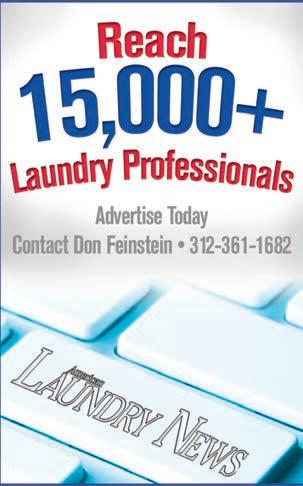

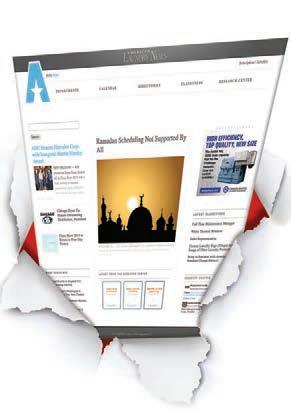






22 january 2014 | american Laundry news www.AmericanLaundryNews.com Source Directory listings in American Laundry News are sold on an annual basis at the following rates: All Major Credit Cards Accepted 2014 Listings Regular Boldface All Caps All Caps, Boldface Four Line Listing per Year $820 $1,030 $1,030 $1,090 Display and additional line rates available upon request Gardner Machinery Corporation P. O. Box 33818, Charlotte, NC 28233 Ph.: (704)372-3890; Fax: (704)342-0758 www.gardnermachinery.com materiaL HandLing / conveyors source directory A convenient guide to sources of products and services FLatworK ironers Setting the Standard in Lint Filters for 25 Years • Hotel • OPL • Coin Op • Dry Cleaners • Industrial • Commercial • Cruise Industry Dry or Wet Style Filters to Work with “ALL” Dryer Sizes or Multiple Situations, Fiberglass or Stainless and Custom for Unique Situations! All manufacturing done on premise 800-826-1245 www.cleancyclesystems.com • ccsystems@tqind.com parts Knowhow In Action Your Tingue rep is a fully trained master of finishing equipment operation, maintenance and installation. Call for: • Pads, covers, belts, waxes, tapes and more • Carts, trucks, baskets and bags • Parts, rebuilds and repairs 800.829.3864 www.Tingue.com TalleyMachinery.com MODLaundry.com TBR-Associates.com To website Lint coLLectors & FiLters H Our In-Line Lint Filter mounts inside, saves space! H Fiberglass Wet Filters - 6,000 to 40,000 cfm H Fiberglass or Stainless Steel Dry Filters ENERGENICS CORPORATION Talk with our Design and Engineering Staff about your needs. Hundreds Sold Annually. 800-944-1711 www.energenics.com parts C & W EQUIPMENT (800) 443-3573 FLATWORK IRONER SPECIALISTS REMANUFACTURED IRONERS: Super Sylon Sylon Hypro’s Super Pro Jensen SS700 SS800 Ultima Lavatec UPGRADE KITS: Chain Drive Conversion Vacuum Systems Herringbone Conversion Canopies Inverters Side Covers Roll Springs Jensen Drives SUPPLIES: Aprons Pads Covers Belts Waxes Cleaners PARTS/REPAIRS: All Brands New/Refurbished/Hard to Find COMMITTED TO EXCELLENCE Get the info you need online... AmericanLaundryNews.com 2013aln_aln.com_class.indd 1 contact us to book your ad TODAY! classifieds@americantrademagazines.com
Pellerin

P.O. Box 400, Kenner, LA 70063 504-467-9591, Fax: 504-468-3094 www.milnor.com
TYING MACHINES
FELINS USA, Inc. Milwaukee, WI Tying, Banding & Automated Shrink Wrap Systems 800-843-5667 sales@felins.com For more information visit us at www.felins.com


WASHERS – CONTINUOUS BATCH

















Pellerin Milnor Corp.
P.O. Box 400, Kenner, LA 70063 504-467-9591, Fax: 504-468-3094 www.milnor.com
WASHER-EXTRACTOR
Pellerin Milnor Corp.
POUNDS OR LESS
P.O. Box 400, Kenner, LA 70063 504-467-9591, Fax: 504-468-3094 www.milnor.com
WASHER-EXTRACTOR

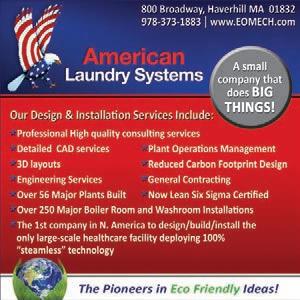
Pellerin Milnor Corp.















P.O. Box 400, Kenner, LA 70063 504-467-9591, Fax: 504-468-3094 www.milnor.com

www.AmericanLaundryNews.com AMERICAN LAUNDRY NEWS | JANUARY 2014 23
– 100
POUNDS OR MORE
– 100
Milnor Corp.
PRESSES – EXTRACTION Source Directory A convenient guide to sources of products and services PLANT DESIGN & INSTALLATION Source Directory listings in American Laundry News are sold on an annual basis at the following rates: All Major Credit Cards Accepted 2014 Listings Regular Boldface All Caps All Caps, Boldface Four Line Listing per Year $820 $1,030 $1,030 $1,090 Display and additional line rates available upon request Company Web Site Page Company Web Site Page INDEX OF ADVERTISERS A.L. Wilson Chemical Co. www.alwilson.com 15 American Dawn www.americandawn.com 7 American Laundry Systems www.eomech.com 8 ARTA www.arta1.com 11 Direct Machinery Sales Corp. www.directmachinery.com 20 The Griffin Group, Inc. www.thegriffingroup.cc 20 Kannegiesser USA www.kannegiesser.com 13 J.P. Equipment www.ineedjpequipment.com 20 LaundryCareers.com www.laundrycareers.com 20 Lavatec Laundry Technology www.lavatec-laundry.com 24 LG www.lgcommerciallaundry.com 5 Lubbert Supply www.lubbertsupply.com 19 Royal Basket Trucks www.royal-basket.com 18 Stanco Industries www.stancoind.com 20 UniMac www.unimac.com 3 U.N.X. Inc. www.unxinc.com 17, 20 THE WIRE The latest news, straight to your inbox, 2X a week A & B WIPER SUPPLY You’re probably not getting enough for your linen discards! We pay TOP DOLLAR for your discarded sheets, towels, thermal & flannel blankets. Call us for an immediate quote: 800-333-RAGS (7247) We’re Hiring! Textile Buying & Sales Executive Positions Available E-mail Résumés to resumes@bestrags.com RAGS WANTED FOR CASH OR TRADE
